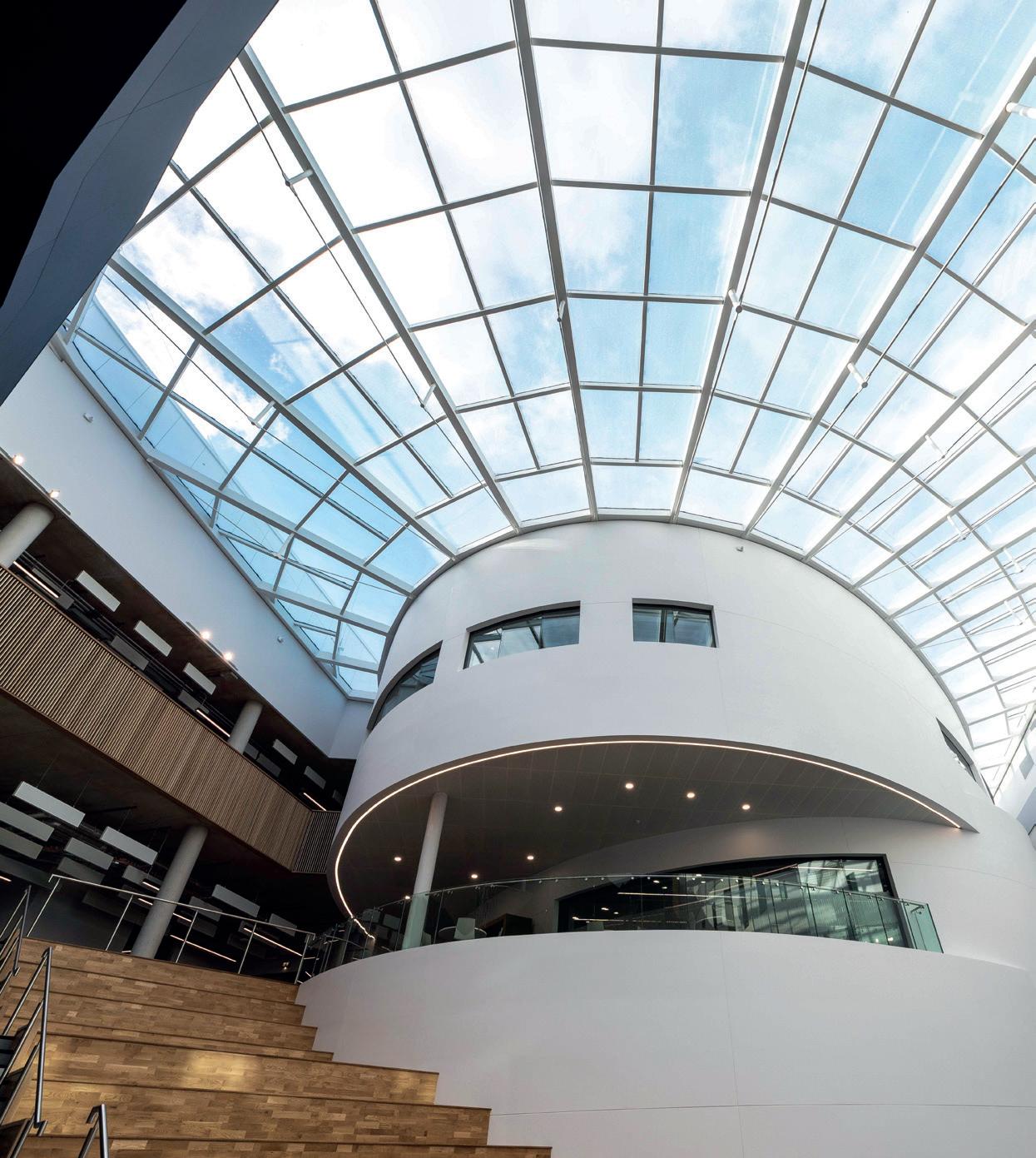
May 2023 Issue 129 Public Sector Build Journal Leisure Housing Education Healthcare psbjmagazine.com
MAKING WAVES
How university building design can inspire collaboration and accelerate innovation
Manchester Museum reopens following a major transformation
Euroclass fire ratings: The difference between A1 and A2
Golden Coast explores innovative lighting in swimming pool halls
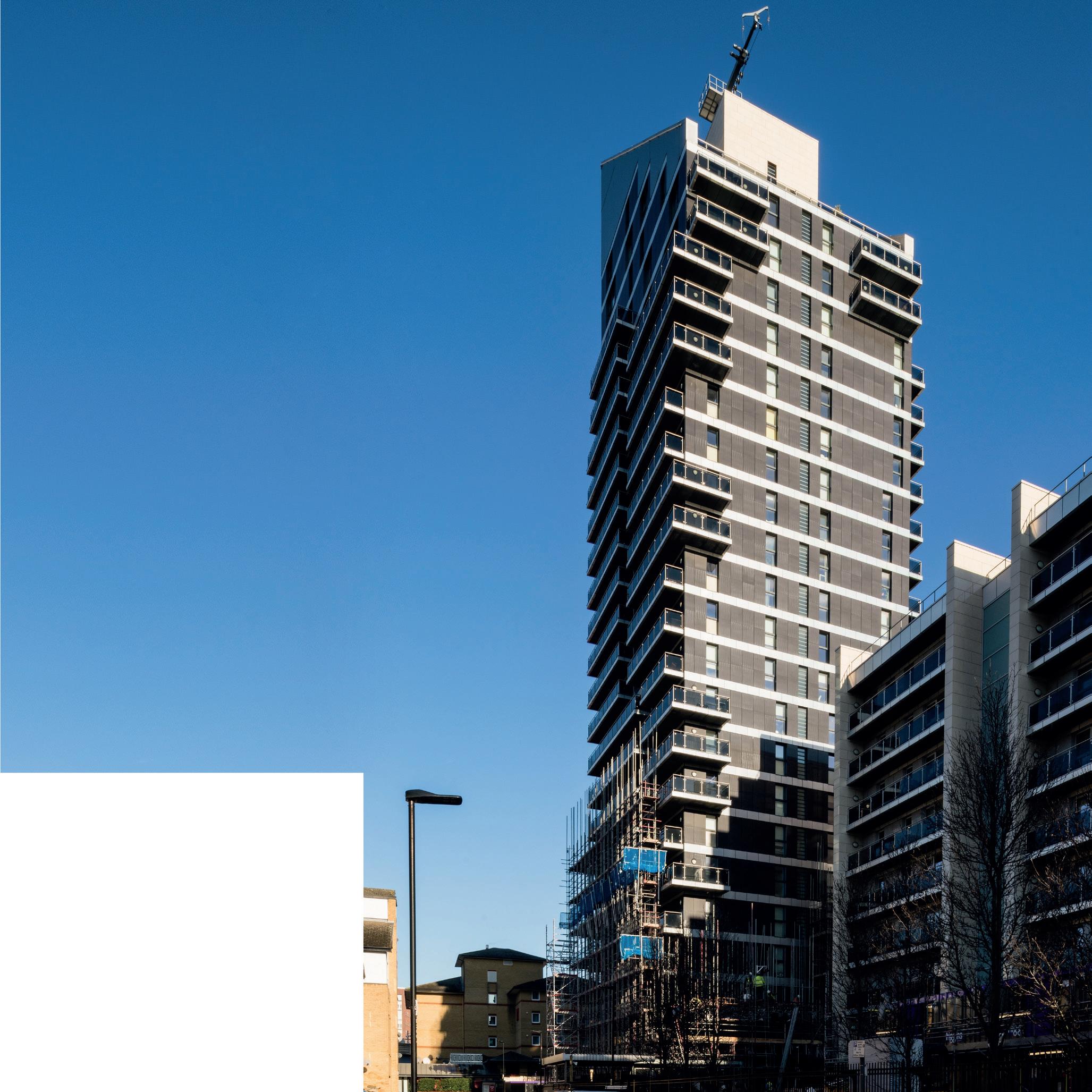
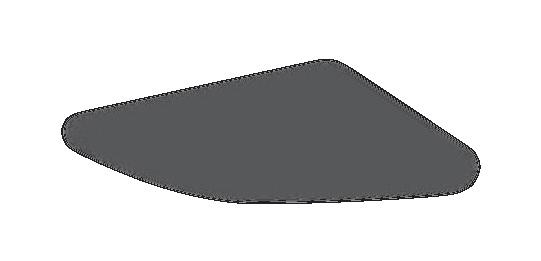

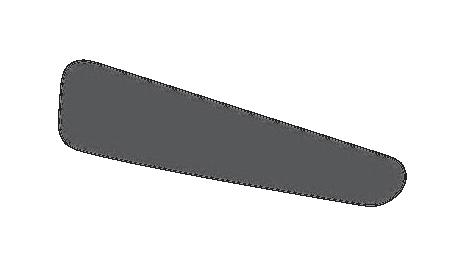
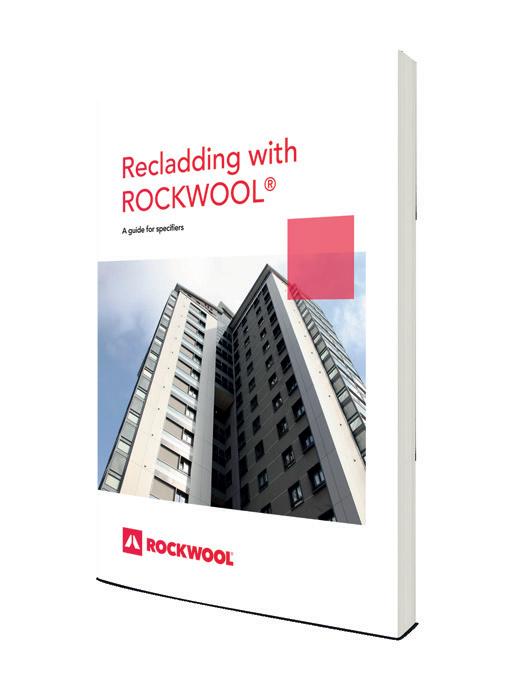

Welcome to the May issue of PSBJ...
In this edition, PSBJ offers some timely insight on the new Fire Safety (England) Regulations 2022, which came into force at the beginning of the year, and explores how these are impacting specific areas of the industry.
For the door sector, the latest wave of fire safety reforms can help to address some key concerns, says Karen Trigg of Allegion UK. Under Regulation 10, The Fire Safety (England) Regulations 2022 made it a legal requirement from 23rd January 2023 for responsible persons for all multi-occupied residential buildings in England with storeys over 11m in height to undertake quarterly checks of all fire doors (including self-closing devices) in the common parts; and undertake – on a best endeavour basis – annual checks of all flat entrance doors (including self-closing devices) that lead onto a building’s common parts. Turn to page 30 to read about what these latest updates mean for decision makers overseeing fire door safety in high-risk residential buildings.
Elsewhere, in this month’s Talking Point found on page 32, Kieran Bradley, Director of Architecture at leading independent property, construction and infrastructure consultancy Pick Everard, examines the implications and considerations of the new fire safety regulations specific to facade design.

Meanwhile, despite the Government’s temporary exemption of the combustible product ban on buildings over 18m, John Duffin, Managing Director of Keyfix, discusses the difference between A1 and A2 Euroclass fire ratings. With the plan to revert to noncombustible cavity tray products in December, this article provides some welcome guidance to ensure best practice now and in the future. Turn to page 34 to learn more.
Also in this month’s issue, Optima Systems discusses why businesses should be adopting a circular approach, HLM reflects on how university building design can inspire collaboration and accelerate innovation, and WMS takes a closer look at the specification of heating systems.
I hope you enjoy this issue. Don’t forget, you can also access the magazine’s features, product news and supplier information on PSBJ’s user-friendly and engaging website. Fully responsive, the website allows you to read all the latest stories on-the-go either on your phone or tablet. Simply visit www.psbjmagazine.com
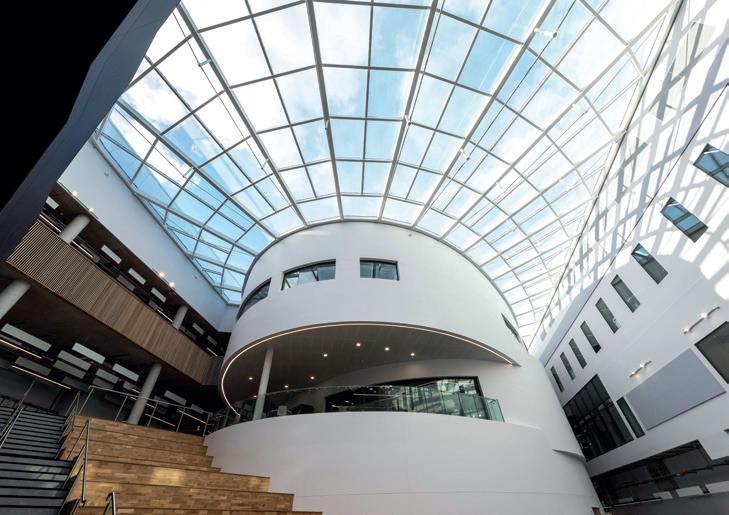
03
Hannah Woodger • Editor • hannah@redhutmedia.com Find us on Social Media: Hannah WELCOME NOTE @psbjmagazine
HLM Architects discusses why it is vital to approach interior design in our university buildings in a way that can cultivate a deeper level of engagement between all users. See page 12.
06 News
A round up of the latest industry news, including charity events, awarded contracts, completed projects and much more.
08 Upfront
Following its ambitious £15m transformation, Manchester Museum reopened its doors in February with the aim to build a greater understanding between cultures.
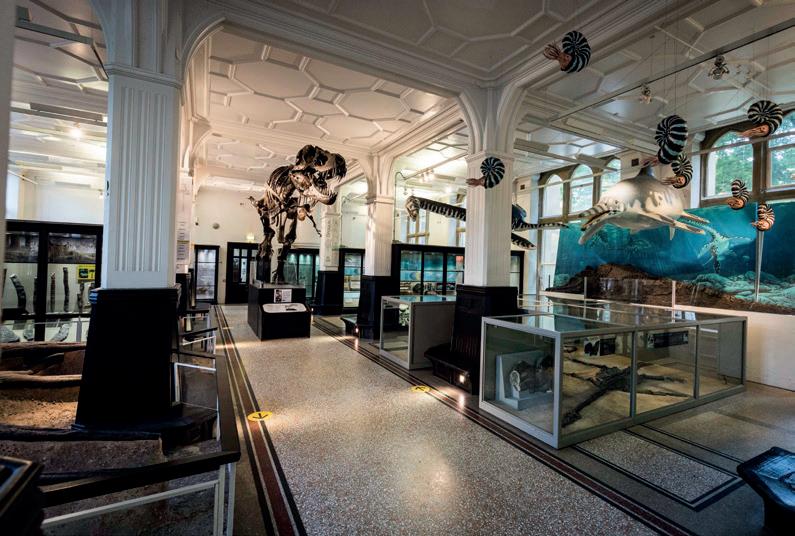
12 Education
Amy Hipwell, Interior Designer at HLM Architects, explores how university building design can inspire collaboration and accelerate innovation.
14 Legal & Business
John Rodgman, Managing Director of Borehole Solutions, explains what an environmental impact assessment actually is and why every project should have one.

16 Housing
Carl Yale, Regional Refurbishment Director at Lovell, reflects on his experience of the SHDF demonstrator and Wave 1 phases with lessons learned to take forward to Wave 2.
08
18
Floors, Walls & Ceilings
Jonathan Reed at Amron Architectural talks to PSBJ about the increased use of metal mesh ceiling systems amongst architects and designers in commercial and public spaces.
20 HVAC
Joanna Crown, Marketing Director at WMS, takes a closer look at the specification of heating systems and explains why underfloor heating is the ideal, futureproof solution.
22 Interiors

Lee Spencer, Head of Operations at national contractor Novus Property Solutions, discusses the benefits of choosing a specialist contractor for live retrofit projects.
24 Healthcare
BCMS is a 6500m2, purpose-built vocational skills and education training centre, which is being built on the grounds of the Royal Bolton Hospital NHS Foundation Trust site.
04 CONTENTS
26 Circularity
Adopting the circular approach: how and why?
Christian Mabey, Managing Director of Optima Products, takes a closer look at the benefits of achieving circularity in your business.
28
Leisure
Adam Clark at wet leisure distributor
Golden Coast reveals why it is essential to get the right lighting in a pool hall, and how new innovations are paving the way for safer spaces.
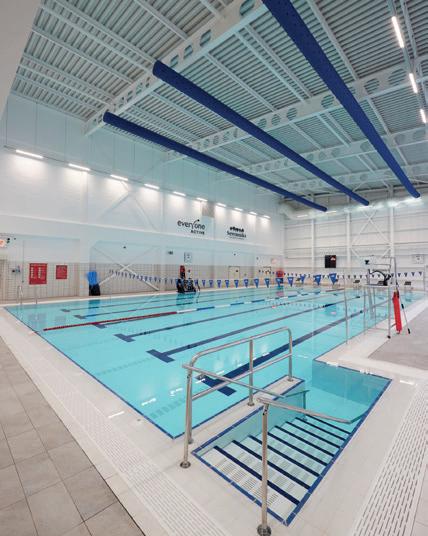
30 Fire Safety
The fire risks associated with multi-occupied residential buildings remain high on the sector’s agenda, and the latest wave of fire safety reforms can help address key concerns.
32 Talking Point
With the new Fire Safety (England) Regulations 2022 now in force, Kieran Bradley at Pick Everard examines the implications and considerations specific to facade design.
34 Technical Focus
Here, John Duffin, Managing Director of Keyfix, sheds some light on the difference between A1 and A2 Euroclass fire ratings.
36 Product Showcase
PSBJ offers readers a dedicated focus of industry news, products and case studies to help architects, specifiers and local authorities make informed decisions.
Specifying a CFA member for your next flooring project could mean the difference between success — or a flooring failure. Most of the UK’s largest and best known Manufacturers, Distributors, Contractors and Consultants are CFA members — and for good reason.

• CFA members promote high standards, knowledge and expertise
• CFA members will maximize your investment and minimize costly flooring failures — which is good for your client, good for your reputation and also helps promote future business
• All members have to pass a vetting process
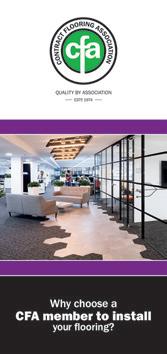
05 CONTENTS 18 28
Tel: 0115 941 1126 www.cfa.org.uk Email: info@cfa.org.uk
See the “Downloads” section at www.cfa.org.uk and download our leaflet TODAY Specify CFA Members_Sep 2021_HP_all sizes.indd 2 24/09/2021 16:25:00
INDUSTRY UPDATES
Each month, PSBJ rounds up the latest public sector construction updates, from new contracts to industry awards.
Planning application submitted for Inverclyde’s new Adult Learning Disability Hub

A planning application has been submitted for a new sustainable and inclusive Adult Learning Disability Hub in Inverclyde, designed jointly by architects at Holmes Miller and Inverclyde Council, working in partnership with hub West Scotland. The £10m facility, which will be located on Brachelston Street on the site of the former Hector McNeil Memorial Swimming Baths, will replace the current Fitzgerald Centre in Greenock. It will provide day care facilities and enhanced learning activity spaces for up to 50 adults with learning and physical disabilities within the Inverclyde community. Construction of the centre is expected to start on site in summer 2023. To deliver on Inverclyde Council’s net-zero aspirations, a ‘fabric-first’ approach to design has been adopted at the new centre, which will result in an efficient and low-energy building. Carbon emissions will also be offset by a large array of roof-mounted solar photovoltaic panels. Nada Shehab, Project Architect at Holmes Miller, said: “Our designs are for a building with a human scale and a modern distinctive character, that takes subtle inspiration from prominent Greenock architecture. It has been great working with a strong client group that has a clear vision of how good design can improve the lives and experiences of their service users and their community, both now and in the future.”
Barnet Council services return in house as outsourcing contract ends
Barnet Council services, including planning, highways and environmental health, returned to in-house control in April, following the end of the 10-year joint venture ‘Re’ with outsourcing company Capita. The move sees around 300 Re staff transfer to direct employment with the council. The closure of the Re partnership marks the first phase of Barnet Council’s plan to return outsourced services from the private sector. The council has held outsourcing contracts with Capita since 2013, covering a number of front- and back-office services. The leader of the council, Cllr Barry Rawlings, said: “We are committed to providing the very best services for our residents, that offer value for money and are accountable to council tax payers. We thank our partners in Re and Capita and welcome the transfer of staff to the council’s in-house team.” While some council services are still being delivered by Capita, estates, building services, facilities and print are set to return to council control by September 2023, with systems used to deliver HR and finance ending in 2024. IT, customer services and revenues and benefits will remain with Capita for the time being due to the complexities and scale involved.
Keele University’s new zerocarbon digital innovation centre completes

A new digital innovation facility at Keele University has reached practical completion. The £10.4m Innovation Centre 7 (IC7) will be the home of Keele’s new Digital Society Institute, providing collaborative space for business and research. Designed by HLM Architects, working with Tetra-Tech, Poole Dick, Currie & Brown and William Bailey, and constructed by Bowmer and Kirkland, the 2760m2 building is located on the university’s Science and Innovation Park in Keele, Staffordshire. Forming part of the Keele Growth Corridor University Enterprise Zone, this completion marks a major milestone for Keele University and further builds on its reputation as an outstanding hub of world-leading research and teaching, which aims to address some of society’s most urgent challenges. Designed with sustainability in mind, the IC7 building is intended to be zero carbon in operation and is designed to meet a BREEAM ‘Excellent’ rating. It is fully electric, powered by renewable energy generated by the university’s own onsite solar and wind turbines, part of Keele’s Smart Energy Network Demonstrator. HLM GreenBuild, an alliance between HLM and GreenBuild Consult that provides sustainability consultancy services, was appointed to undertake a passive design analysis to identify ways to cut CO2 emissions and energy demand, resulting in a reduction of 18% in energy use through passive design measures alone, including natural ventilation, orientation and more.
Stepnell awarded place on Southern Construction Construct framework
Complete construction partner Stepnell has been awarded a place on the fifth-generation Southern Construction Framework (SCF) Construct framework, for the new £1m to £5m value lots for the South West. Stepnell is one of six contractors awarded a place on Lot 5 of the latest SCF Construct framework, which supports public sector construction and development in the South West region. The new framework win will see Stepnell build on its presence in the region with greater collaboration, added value, project performance and quality. As part of the selection process, Stepnell was assessed against strict criteria, including being able to demonstrate exemplary carbon benchmarking assessments for all builds. Additionally, Stepnell was able to show prioritised carbon retrofit capabilities, to match industry-leading carbon and social value targets required by SCF. Lewis Archibald, Framework Director at Stepnell, said: “The new framework win reflects Stepnell’s shared values with SCF and how we are committed to providing a full spectrum of construction solutions for the public sector. This is all in line with our ability to offer a truly collaborative approach to deliver high-quality, best-value projects with an emphasis on carbon and social value targets.”
06
NEWS
Low-carbon concrete to become standard on all Laing O’Rourke UK projects
Laing O’Rourke has announced it is mandating the switch to low-carbon concrete on all of its new UK projects. The exclusive use of low-carbon concrete from 1st April this year will accelerate the company’s progress towards its net-zero targets. Following a long-term research programme co-funded by Laing O’Rourke and Innovate UK, and in collaboration with the University of Cambridge and Sheffield University’s Advanced Manufacturing Research Centre (AMRC), the business has proven that a range of low-carbon concrete options can be successfully deployed on projects as a like-for-like substitute for traditional concrete. The overall carbon reduction will be 28% when compared with the company’s concrete usage in 2022. This equates to a saving of 14.4 million kgCO2e, which is the same as planting 120,000 trees or 94 hectares of forest.

Cathal O’Rourke, Laing O’Rourke’s newly-appointed Chief Operating Officer, said: “We’ve committed to being a net-zero company before 2050 and we are looking at every possible measure to accelerate our progress. In construction, the greatest challenge is reducing scope 3 emissions – the embodied carbon in purchased materials. Reducing all carbon emissions is a priority for our business. The built environment makes a significant contribution to global warming and constructors must work with clients and design partners to deploy new technologies and innovations that make modern methods the norm and enable us to build in less carbon intensive ways.”
TLT advises Brent Council on Wembley Housing Zone
TLT’s real estate group has advised Brent Council on a deal with Wates Construction to deliver new homes in the Wembley Housing Zone – two housing developments featuring affordable and private homes. Wates Construction is one of the leading privately-owned construction, residential development, and property services businesses in the UK. Led by housing and regeneration partner David Meecham, TLT advised Brent Council on the procurement of Wates as the hybrid developer and contractor for the two sites, Cecil Avenue and Ujima House. Cecil Avenue will feature 250 homes, as well as commercial and community spaces. Ujima House will have 54 new affordable homes, new workspace units and a cafe. Designated and partly funded by the Mayor of London, the Wembley Housing Zone aims to create new homes and jobs, new leisure, retail and workspaces, public realm improvements and increased accessibility for pedestrians, cyclists and road users. Brent Council was also supported by its commercial adviser, Deloitte, led by Director Alex Morton. Jonathan Kay, Head of Regeneration at Brent Council, said: “This exchange is a significant milestone for the council in completing the Wembley Housing Zone project, ensuring the revitalisation and regeneration of this up-andcoming neighbourhood. TLT’s efficient work, advice and knowledge of public sector-promoted residential development schemes was invaluable in securing the agreement in time.”
Innovative construction delivers Fulbourn Hospital’s sustainable Resource Centre

A new Resource Centre has been opened at Fulbourn Hospital to provide the local community with a modern and sustainable healthcare hub tailored to the needs of patients and staff members. Cambridgeshire and Peterborough NHS Foundation Trust’s (CPFT) new £5.8m building features a gym, offices, social and recreational spaces as well as physio and occupational therapy areas. At the end of March, a new branch of The Edge Café also opened at the centre. The opening follows a year-long building programme by Morgan Sindall Construction’s Cambridgeshire business with project managers Northmore, to create a two-storey, 1200m2 facility on the site of the hospital’s previous Resource Centre. Repurposing existing buildings was a key part of the construction process in order to achieve the CPFT’s sustainability targets. Morgan Sindall utilised its Intelligent Solutions approach to adopt an innovative modular construction method which saw 25 existing modules from the former Papworth Hospital transported to the site and renovated into a modern healthcare facility. Jamie Shearman, Area Director for Morgan Sindall Construction in Cambridgeshire, said: “It’s great to see the Resource Centre’s doors open, as we know that it’s going to deliver a long list of benefits for the local community. The centre will not only act as a gateway to the hospital, but it also provides a much-needed activities and leisure hub, which is crucial for patients and carers.”
GRAHAM secures its place on the new £4.5bn Southern Construction Framework
Southern Construction Framework (SCF) has awarded GRAHAM a place on its £4.5bn construction framework for work on public sector projects in the south of England. GRAHAM has been awarded all of the lots applied for, the highest value bands for projects in London, south-west and south-east England. SCF is a leading construction procurement framework delivered by the public sector for the public sector in the South of England (SW, SE and London). It has delivered over £8bn worth of combined construction schemes, helping clients to deliver around £500m building work every year since it began in 2006. SCF provides construction procurement across public sectors including education, health, sport and leisure, fire and police and Build to Rent (inc. hotels, industrial units, offices). This is the organisation’s fifth-generation framework and will run until 2027. It covers public sector construction work in education, healthcare, leisure, emergency services and local Government, and has a total of five lots. Rod McMullan, GRAHAM Director for the framework, said: “We are delighted and excited by gaining a much sought-after place on SCF Construct, which is an industry-leading framework achieving value from two-stage procurement with a collaborative and flexible approach. This follows on from our recent success in gaining a place on the SCF Residential framework and adds to our portfolio, offering and growing presence in the south of England.”
07
NEWS
MANCHESTER MUSEUM REOPENS TO THE PUBLIC
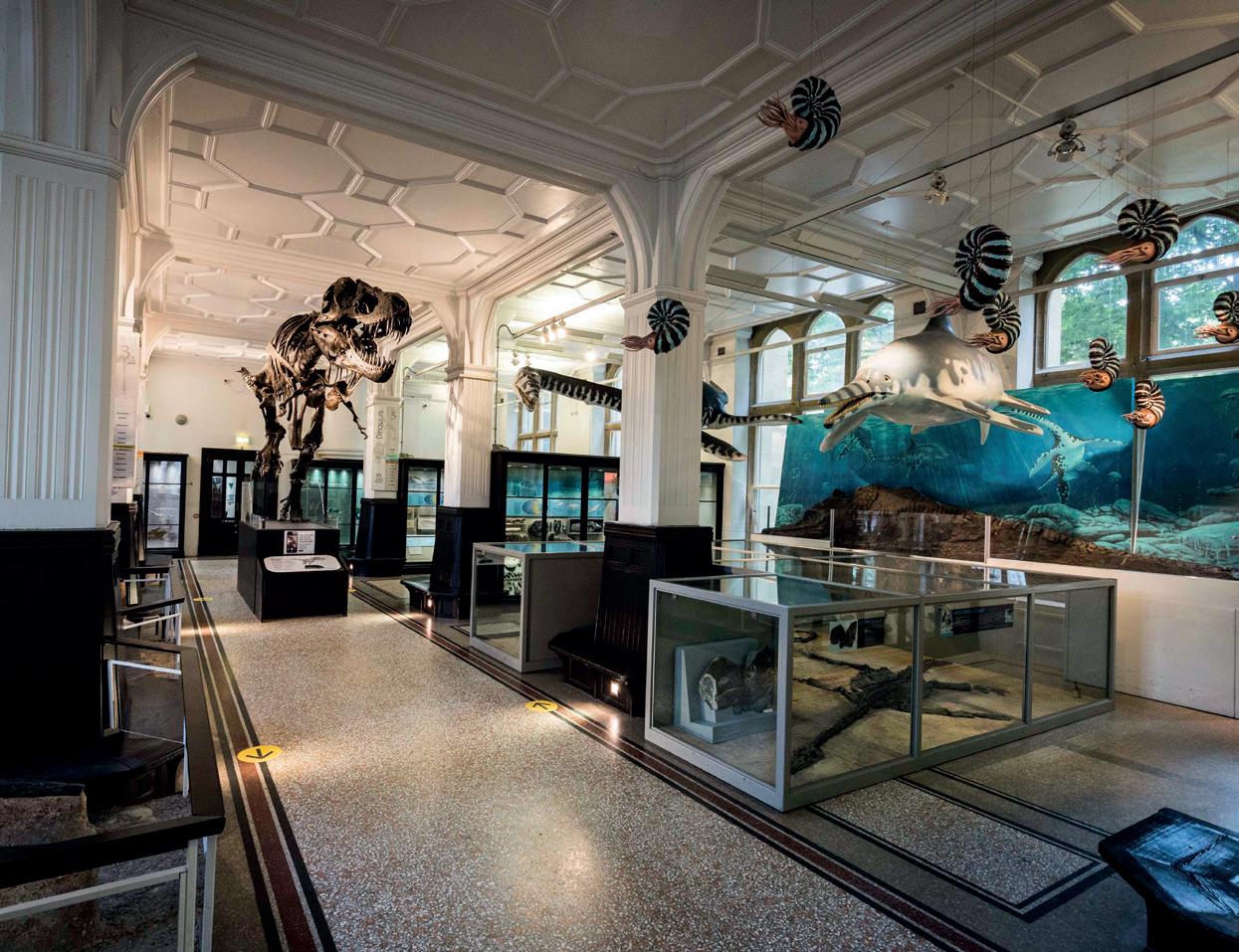
FOLLOWING MAJOR REDEVELOPMENT
Following its ambitious £15m transformation, Manchester Museum reopened its doors in February with the aim to build greater understanding between cultures, a more sustainable world and to bring to life the lived experience of diverse communities through the museum’s historic collections and new displays.
Esme Ward, Museum Director of Manchester Museum, says: “The reopening marks a huge moment in Manchester Museum’s rich history as we open our doors following a major transformation. We have extended the building, making room for more joy and learning and evolving into the museum Manchester needs.
“Beautiful new galleries and exhibitions will showcase the best of the museum’s historic collections, as well as addressing the urgencies of the present day and highlighting the complexities of our world. We have also listened to advocates with lived experience, and inclusive new spaces and features are incorporated throughout. We are delighted to welcome our visitors back.”
Exciting new galleries include the South Asia Gallery, a British Museum partnership and the UK’s first permanent space to explore the lived experience of South Asian diaspora communities. There is also a new Lee Kai Hung Chinese Culture Gallery, the Belonging Gallery, a brand-new dinosaur display and Golden Mummies of Egypt, its first blockbuster exhibition opening in the new exhibition hall.
Manchester Museum, part of the University of Manchester, first opened in 1890 and is recognised as one of the largest university museums in the UK. The original Neo-Gothic building, designed by renowned Architect Alfred Waterhouse (1830–1905), is home to around 4.5 million objects from
natural sciences and human cultures. Proud to be the world’s first carbon-literate museum, the team has recycled and reused as much material within the building during renovation works.
Designed by Purcell, the modern twostorey extension houses a major new exhibition hall and South Asia gallery, alongside a new accessible entrance from Oxford Road and a new cafe and shop. The extension is clad in green-glazed terracotta tiles and pays homage to craftsmanship as well as Victorian and Edwardian period buildings in Manchester. Other new features include a Changing Places toilet, prayer room, quiet room, picnic area and therapy room.
UPFRONT 08
SOUTH ELEVATION

Exhibition hall
The exhibition hall is home to ambitious shows that explore past, present and future and engage with global and local narratives. The opening exhibition, Golden Mummies of Egypt, offers visitors unparalleled access to the museum’s world-class Egypt and Sudan collection and challenges Victorian narratives of ‘Ancient Egypt’ through new research from the University of Manchester. Featuring more than 100 objects and eight mummies, the UK debut, and final destination, of the exhibition’s running follows a hugely-popular tour across USA and China and presents a rich perspective on beliefs about the afterlife during Egypt’s Graeco-Roman period (332 BC to 395 AD), with highlights including elaborately-decorated mummies known as ‘Fayum Portraits’.
South Asia Gallery, a British Museum partnership
The South Asia Gallery, a British Museum partnership, is the first permanent gallery in the UK to celebrate the lived experiences and contributions of the South Asian diaspora. Cocurated with the South Asia Gallery Collective, a group of 30 individuals including community leaders, educators and artists, the gallery explores the connection between South Asia and Britain and the legacy of Empire alongside contemporary South Asian culture and creativity, perspectives that have not been presented before.
Divided into six anthologies, the collective has grappled with a range of subjects through 140 artefacts, including one of the collective’s great-grandfather’s World War I uniform, a rickshaw imported from Bangladesh and decorated by communities in Manchester, a new commissioned mural from British Artists, the Singh Twins – an emotional map of South Asian diaspora experience – and a Cartier brooch containing a repurposed, carved emerald from the Mughal Empire. At the heart of the gallery is also a dedicated space for performance, film and participatory activities.
Lee Kai Hung Chinese Culture Gallery
The Lee Kai Hung Chinese Culture Gallery highlights personal stories of migration, friendships and collaboration to inspire empathy and build understanding. Developed in partnership with the university’s Manchester China Institute, it draws on historical and contemporary links between Manchester and China.
Showcasing rarely- and never-displayed collections from cultural partners across the city, personal stories and objects include a late Qing Dynasty (1636 to 1912) ‘Manchu’ headdress decorated with blue kingfisher feathers, a 20m scroll showing Emperor Kangxi’s birthday procession through the streets of Beijing in the 18th century and a taxidermy milu deer, once on the brink of extinction but now thriving in China after decades of transnational conservation efforts. A night sky constellation – our shared sky – also encourages people to gather and connect through cultural exchange and performances.

09 UPFRONT
Dinosaur display
One of the museum’s mostvisited exhibits, the prehistoric giant Stan the Tyrannosaurus rex, returns alongside a new addition, April the Tenontosaurus. The museum worked with a team of earth science students from the University of Manchester, whose new research and several years of cataloguing have allowed April’s skeleton, dating back to the Cretaceous period and found in Montana, USA, to stand on all fours again. Positioned next to the historic Fossils Gallery, the brand-new dinosaur display also teaches visitors, while palaeontology enthusiasts will learn what it means to think like a palaeontologist at the brand-new dinosaur display.
Our changing world is a focal point throughout, with featured objects such as fragmented rock showing the moment the asteroid hit earth, relating to our understanding of evolution, climate change and outer space.
Belonging Gallery
The new Belonging Gallery captures the welcoming spirit of the museum, drawing upon the museum’s collections and diverse cultural perspectives to reflect on what it means to belong.


Following an open call, the exhibition presents the work of multiple visual storytellers, who bring their own life experience to comic art. Aiming to rewrite the past and inspire new futures, works include indigenous and African futurism, explored alongside artefacts and natural history specimens from the museum’s collections. Stories include the climate migration of the first people to Britain during the last Ice Age and the poignant story of a Syrian refugee’s life jacket, collected in 2017.
The gallery has been curated by Alexandra P. Alberda, the first-ever curator of indigenous perspectives at Manchester Museum. She was appointed to take forward the innovative ‘Indigenising Manchester Museum’ programme, funded by the John Ellerman Foundation, which sets indigenous perspectives at the heart of the museum. She is also undertaking provenance research with “source and diaspora communities” as part of the museum’s proactive approach to repatriation.
www.purcelluk.com
10
UPFRONT


Specialists in modular construction CONTACT US TODAY 0800 18 18 22 | www.wernick.co.uk buildings@wernick.co.uk 50+YEARS DESIGN LIFE SUSTAINABLE CONSTRUCTION FULL PROJECT MANAGEMENT MINIMUM ON-SITE TIME FLEXIBLE EXPANDABLE WERNICK MODULAR BUILDINGS DELIVER... Scan the QR code our latest watch video Wernick have decades of experience in the education sector Wernick Group’s commitment to a sustainable future
HOW UNIVERSITY BUILDING DESIGN CAN INSPIRE COLLABORATION AND ACCELERATE INNOVATION
n an increasingly competitive global education market, UK universities need to provide world-class facilities to stay ahead of the curve and attract the best students and academic talent. Consequently, there is a shift happening towards more collaborative working and learning practices, and spaces that spark those ‘incidental’ meetings and conversations that can lead to innovative research and breakthroughs. Effective design plays a major role in supporting this trend as well as futureproofing our higher education establishments.
HLM Architects worked on the interior design of ‘The Wave’, a new 16,500m2 Faculty of Social Sciences building at the University of Sheffield, intended to help meet future growth demand and further cement the university’s reputation for leading teaching and research. It is also a fitting example of an environment designed to enable collaboration and interaction to take place organically and easily.
The Wave features bespoke accommodation for a number of academic departments, alongside shared facilities for the entire faculty including a collaborative, centralised research hub. A mix of social learning spaces are dotted around the

building to encourage movement out of what were previously more cellular spaces into the centre of the hub. This approach encourages everyone into the middle, rather than shuttered in their own sections around the building’s periphery – the design actively encourages fruitful discussion and the cross-pollination of ideas.
More adaptable and active learning spaces
Flexibility was key to this project, not least as a way to address some of the challenges within the higher education sector, such as the need for greater agility, accessibility and inclusivity, more multifunctional spaces (formal and informal) and the ability to adapt based on demand.
To that end, much of the furniture is loose, foldable and simple to rearrange or relocate to different rooms, depending on the needs of each course, without looking out of place. A focus on ‘active’ learning enables people and furniture to move freely instead of being fixed in place or restricted.
In the 400-people lecture theatre, for instance, students can move their seating around with ease and the lecturer can walk around and communicate more closely with them. This is boosted by the integration of
digital technology, and some of the spaces have a screen at each desk, improving visibility for all and removing the typical hierarchical set up of learning spaces (with a lectern at the front and allocated seating) by allowing students to seamlessly share their work across all screens in the room for collaborative learning.
We need fresh thinking when it comes to education spaces and layouts, compared to the more passive learning styles of the past. Taking a less traditional approach to design enables the spaces to be more interactive and facilitates better group work. This is especially important for social sciences because of the wide variety of courses being run, each of which is structured differently, and the ability to reconfigure spaces quickly through use of furniture can help to tailor them accordingly.
Creating a sense of openness and cohesion
One of the chief design objectives was to make the building feel like one whole and belonging to everybody, encouraging a sense of connection and collaboration. There is one colour palette throughout, with no zoning or distinct colours demarcating the different departments or functions. This
12 EDUCATION
I
Amy Hipwell, Interior Designer at HLM Architects, discusses why it is vital to approach interior design in our university buildings in a way that can cultivate a deeper level of engagement between all users.
makes all spaces feel interlinked for that all-important feeling of cohesion and helps to incorporate the public spaces such as the ground-floor cafe, thereby melding the local community and the university and reiterating the open, inviting nature of the space. The thoughtful design concept enables a clear visual connection between the interior and the surrounding landscape, with only the expansive glass panes in between, removing the impression of ‘solid’ boundaries.
Biophilia was another major design factor, due to the well-proven benefits of natural light and views of greenery on wellbeing, motivation, productivity and inspiration. This extended into the internal finishes, where the use of textures and materials (such as timber) helped to create a more natural environment. The textured carpet, for instance, has a lighter colour tone by the windows, mimicking natural light entering the room and becoming darker as it progresses inwards. The space reflects the interdisciplinary nature of social sciences with a series of overlapping organic curved floor plates that ebb and flow – while hinting at the site’s history as a reservoir.
The floor plates also support occupants’ thermal comfort, and consideration was given to how they can minimise solar glare and shading, prevent overheating and improve insulation. This also brings considerable sustainability advantages, with the building designed to BREEAM ‘Outstanding’, adding to the forwardthinking approach.
At the heart of the atrium and spanning all three floors is the iconic central drum, designed in a way that does not interrupt the open, bright and airy feel. Rather than a huge monolithic block, the drum is curved and effortlessly integrated into the space. It features balconies and provides muchneeded accommodation but also the ‘wow’ factor. It enables visibility from all sides and levels, and is the only purely white element of the design, covered with a solid surface material for optimum durability. The team also wanted to encourage people to mingle and use the central staircase, so made it another standout feature. It is black (a striking contrast to the white drum) supported by steel, making it appear suspended above the main circulation space. The choice of materials and textures was crucial – the staircase is covered with a matte laminate that is warm and velvety soft to the touch and doesn’t leave marks or fingerprints, strengthening the ongoing usability of the space.

It is vital to approach interior design in our university buildings in a way that can cultivate a deeper level of engagement between all users. This can be a catalyst for the exchange of ideas across different disciplines, accelerating discovery and spurring innovation and ground-breaking research.

www.hlmarchitects.com

13 EDUCATION
WHAT IS AN EIA AND WHY SHOULD EVERY PROJECT NEED ONE?
With climate change continuing to take centre stage across the building industry, the environmental impact of people and businesses has become increasingly scrutinised. Sustainable living within the building industry has long been subject to criticism regarding its significant contribution to global carbon emissions. It is, therefore, unsurprising to see growing pressure from communities, Governments and environmental activists alike lead to the greater scrutiny of many project’s planning stages. In particular, the introduction of environmental impact assessments (EIAs) as a critical component of the development process. Despite only legally being required for specific larger or more risky developments, more businesses are seeing EIAs become a staple across the building industry as a whole, regardless of the size or stature of the product.
What are environmental impact assessments?

Environmental impact assessments are implemented throughout the planning stage of a project to identify any potential environmental issues that could arise during and beyond its construction. Possible concerns could include groundwater contamination, soil quality, damage to the local ecosystem, as well as noise, water and air pollution emitted as a by-product.
Under the Environmental Impact Assessment Regulations 2017, developments classed as
‘schedule 1’, such as power plants and chemical treatment sites, will always require an in-depth EIA to be conducted. Those that fall under ‘schedule 2’, however, are more discretionary, and will only require an EIA should the likelihood of negative environmental impacts occurring be high. The scope of these assessments is relatively broad, however, so chances are you’ll have to carry out an EIA of some sort.
Five-step EIA process
As set out by the UK Government, EIAs consist of five main stages. Firstly, a general inspection of the proposed development is made to determine the likelihood of negative externalities occurring, and whether further assessment is required. The second process – scoping – will then look to determine the extent to which these externalities should be considered within an EIA. Further clarification can be obtained through a ‘scoping opinion’ from the local planning authority.
The next step is preparing and submitting an environmental statement (ES) should it be decided that a full EIA is necessary. This statement will lay out any possible impacts that could arise in as much detail as possible, as well as how the development is expected to comply with planning policy, the planned use of the development and more. The general public will have full access to this statement.
John Rodgman is the Managing Director of Borehole Solutions, a leading provider of geotechnical drilling solutions within the UK, with over two decades of experience in the industry. Borehole Solutions is a proud member of a number of prestigious industry bodies, from the CHAS and RISQS to Construction Line and more.

The local authority will then determine whether or not to proceed with the proposed development upon consideration of the environmental statement. For particularly large projects, the secretary of state will often have a say in the outcome of the decision.
www.boreholesolutions.co.uk
14
LEGAL & BUSINESS
John Rodgman, Managing Director of Borehole Solutions, talks to PSBJ about the importance of an environmental impact assessment (EIA) and details the five-step process when conducting this thorough examination.
“We found Tough Furniture by accident because we were initially looking for some chairs for our SEN provision... but we have stayed with them on purpose, as everything we have ever bought from them has been stylish, of excellent quality and robust. This year, in a new refurbishment, they were our go-to suppliers because we know we are making an investment in something that will last the school a long time and give the students the learning environment they deserve - safe, attractive and easy to maintain - so that their classrooms always look fabulous. Thank you, Tough Furniture! Highly recommended for any school, but especially one as wonderful as ours!
 Beth Elkins Gretton School Cambridge, UK
Beth Elkins Gretton School Cambridge, UK
Designed for SEN Environments
Classroom Seating

Reception Seating
Outdoor Seating
Noticeboards
Dividing Screens
Workstations
Computer Desks
Storage Cupboards
Display Units
Heavy Duty Tables

TV Protection
Bespoke Solutions
15 “
Ltd. www.toughfurniture.com 01588 674 340
Tough Furniture
Furniture
built to last
LESSONS
LEARNED: MAKING SHDF WAVE 2 A SUCCESS
After completing projects as part of both the Social Housing Decarbonisation Fund (SHDF) demonstrator and Wave 1 phases, Carl Yale, Regional Refurbishment Director at leading housebuilder Lovell, says that many lessons have been learned that must be reviewed and taken forward to ensure that Wave 2 projects are a success in the eyes of social housing clients and customers impacted by fuel poverty.
Demonstrator and Wave 1 –lessons learned:
I remember first looking at the new PAS 2035 standard in January 2021 and, probably like most of my peers, saw it as a positive opportunity to retrofit so many homes and tackle some of the issues at the heart of fuel poverty. However, I soon realised that PAS 2035 was far more complicated than the previous PAS 2030-2017 standard. The drive for better-quality installation with designed details and interfaces, alongside improved outcomes was something that my team and I were determined to get involved in, despite its complexity.
We were successful in securing a demonstrator project in the Midlands. The project was a valuable research and development project for Lovell, our supply chain installers and consultants. We faced many


challenges at all stages of the project, but successfully completed the 69 properties and were left in a much better position to deliver for clients throughout Wave 1 and 2.
1. Resource
There is industry concern about the skills gap and the lack of installers available to meet the demand for retrofit. Investment in our own people was needed first and foremost. I completed a retrofit coordinator course, and we recruited an additional coordinator to build our capability and capacity, and to have the knowledge to support our clients and supply chain.
To encourage future training investment from the supply chain, demand shouldn’t be built on short-term energy funding and the secured pipeline needs to be visible. The constant funding deadlines and
16 HOUSING
challenging timescales that are designed around political cycles risk creating chaotic ‘boom-and-bust’ market conditions for retrofit.
Our experience so far has allowed us to develop a network of retrofit consultants and installers. Ultimately, everyone was learning ‘on the job’ each day as we worked collaboratively to fulfil the new PAS 2035 process and put theory into practice. We hope that the lessons learned will allow new projects to progress more quickly and efficiently.
2. Compliance
The shared conclusion was that PAS 2035 was too complex for large projects. The impression was that it was designed for one or a few properties, making scale and pace very difficult when followed as written. For instance, there are some 144 tasks per property that a retrofit coordinator must complete. If we are retrofitting hundreds of properties on a project, then this process must be streamlined.
The level of internal resource required for retrofit projects is significant for the contractor, clients, consultants and installers. A disproportionate amount of my time and that of our team was spent on just a few SHDF projects. This is not sustainable if we need to start ramping up to deliver retrofit at scale and pace.
The prevailing feeling across everyone involved was that PAS 2035 was also too academic. While there were over 200 pages of very good information, PAS 2035 tells us what to do, but not how. This led to a variety of different interpretations of what was needed, all equalling more time and money in the long run.
The PAS 2035 process is very data driven and requires a secure and robust IT platform. Our demonstrator scheme required almost 10,000 documents and photographs to be collated and stored. We then had to upload and lodge the relevant files, at the right time, to TrustMark. Compliance is a huge aspect of retrofit and while lodgement onto TrustMark is one of the last stages of retrofit, it is arguably one of the most important. I encourage people to think about their approach and start with the end in mind.
3. Retrofit design
I believe one of the greatest challenges relates to the role of retrofit designers, who are critical to the success of a retrofit project. I would welcome some specific PAS 2035 guidance on retrofit designs to create some consistency, both in scope of appointment and in terms of detailed content on what a design pack should include. Too often design packs are inadequate for installers and omit essential information.
We see the PAS 2035 process being run back to front or out of sync so often. Clients will come to market with opportunities that don’t include any design information, usually just an indicative schedule of rates that aren’t aligned with PAS 2035 or the retrofit design process. This results in the appointed contractor having to start the whole PAS 2035 process to appoint a coordinator, to then commission assessments and then move to design, which creates a six-month mobilisation period that puts delivery programmes back significantly.
One solution to this is a two-stage approach using a preconstruction service
agreement to undertake initial technical work such as surveys, designs and costings. A viability stage would then be reached to agree scope. This supports an argument for even earlier engagement between clients and contractors.
Wave 2: What can we expect?
Wave 2 will see a real change in desired outcomes. The target is now to achieve EPC C, which is a significant adjustment in terms of appropriate measures and approach, as well as stock choice.
The demonstrator projects required heat demand for properties to be reduced to 50kwh/m2/pa. It soon became evident across the country that this was not an achievable target as it was just too expensive. The Wave 1 target was relaxed to 90kwh/m2/pa and Wave 2 is more focused on value for money. The concern now is that we don’t forget the ‘worst-first, fabric-first’ approach. We must not overlook the expensive solid wall properties that now fall into the ‘too expensive’ or ‘too hard to do’ category and instead chase easy wins to achieve EPC C.
With the successful Wave 2.1 bidders now announced, we would like to see clients starting the PAS 2035 process immediately. SHDF is a positive and real opportunity to help social landlords subsidise the cost of retrofit, create jobs and social value opportunities. But care must be taken in procuring the retrofit partners to deliver. PAS 2035 is complex, cumbersome and resource heavy and is best delivered by those that understand the PAS 2035 process and have a track record in successful delivery.

17
www.lovell.co.uk
HOUSING
A IT’S ALL SYSTEMS GO!
From commercial office buildings to schools and colleges, metal mesh ceiling systems have become a preferred design solution amongst architects and designers. Here, Jonathan Reed, Managing Director at Amron Architectural, talks to PSBJ about the system’s benefits, including occupant productivity, wellbeing and enhanced aesthetics.


rchitects and designers are always looking at more inspirational approaches to the interiors of a space. The demand for creating more inviting spaces and the inclusion of a variety of different applications can completely transform the character of a room. Amongst these approaches, we are seeing an increase in the use of metal meshes both from a point of view that they are generally made from recycled material in the case of aluminum and steel – but also the style and look of them has that upcycled feel that we are all trying to be more conscious of.
Metal mesh has a long tradition of outdoor use spanning hundreds of years. Over time, metal mesh has earned a reputation as a practical, durable yet surprisingly versatile product, thanks in part to its uncanny ability to meet a wide range of specifications. With a variety of practical exterior applications, including vent panels, cages and baskets, it is little wonder that metal mesh was eventually introduced to the world of interiors. Its inherently-superior performance properties led to its adoption as the go-to material for radiator grilles the world over.
Metal mesh is an extremely versatile product and has a functionality like no other. It works well as a safety element, including balustrade infill panels and radiator grilles, but also for decorative purposes like ceilings. In the past, ceilings would not have necessarily been considered within the design aesthetics of a commercial space. The need for a ceiling is obviously vital, but the look and style may often have been overlooked. It is becoming increasingly felt that the ceiling is now being considered as the fifth wall.
Suspended ceilings were first introduced around 100 years ago, they were a novel idea to hide building infrastructure, such as ducting and pipework, and create a space to allow access for maintenance – this is where the mineral fibre tile came in as the most cost-effective way of creating the suspended ceiling. They were cheap and relatively good, acoustically. However, now with the option to use metal mesh in ceilings, it allows a suspended ceiling whilst offering benefits including improved airflow, lighting and vastly improved aesthetics.
18 FLOORS, WALLS & CEILINGS
Look up and be inspired
From commercial office buildings to schools and colleges, metal mesh ceiling systems have become a preferred design solution.
Ideal for challenging projects, due to its decorative virtues and functionality, ceiling systems come in a series of bespoke mesh rafts. Everything is designed and manufactured to meet the design intent on a project. The frames are manufactured from mild steel or aluminium angle, and the mesh is welded into the frame. This ensures the mesh sits flat and provides extra strength overall for the raft.
The rafts have a simple installation and suspension method, which involves threaded bar suspension hangers, which can be used with Fork and Clevis connectors. Rafts can be suspended individually or bolted together to cover a larger area.
Product in practice
Large infrastructure firm, Network Rail, has over 7000 staff members spread across several sites and regions. They wanted to create a central hub for their employees to create a sense of togetherness. Working alongside office refurbishment specialist Oktra, we assisted with the fit-out of Network Rail’s six-storey hub and helped bring their vision to life.
The design intent was to create a central hub for the consolidation of some of their teams, supporting
collaboration and further integration between multi-disciplinary teams. With the plans for this starting just before the pandemic hit, the original design intent was altered to ensure the new office spaces were COVID secure and safe for employees to return to the office.
The same design principles were followed, but the layout was adapted slightly to accommodate for the relaxation of socialdistancing measures.
The office layout features a spacious design with open-plan desks, breakout facilities and a back-of-house meeting suite, which provides a more personal yet laidback meeting environment. Our AC500 cloud ceiling system was specified for this project with 600 x 600mm RB35 expanded mesh lay-in tiles. The frames were manufactured from aluminium to give a lightweight but durable structure.

Colour is one of the main attractions when it comes to the finishing of metal mesh and, in particular, how the mesh is coloured without it corroding. Having researched a number of finish processes that work well with the commonly-used architectural meshes (woven, expanded and perforated), powder coating is the most costeffective way to apply an almost unlimited range of colours. Powder coating uses an electrostatic charge to attract a fluidised powder evenly across all surfaces of the mesh. The electrostatic charge holds the
pigmented powder until it passes through an oven where it melts and adheres permanently to the mesh. After curing, the mesh has a colourful and durable coating that adds to the desired aesthetic of the project.
With Network Rail needing access to the services above, the cloud system was ideal for their requirements. They were powder coated in an array of colours including pink, green, yellow and red to complete the modern look and give a vibrant and welcoming feel to the office.
www.amronarchitectural.co.uk

19
FLOORS, WALLS & CEILINGS
REDUCING EMBEDDED CARBON WITH UNDERFLOOR HEATING

When it comes to reducing a building’s carbon footprint, in the first instance and over its lifetime, there are many factors to consider, including embodied carbon. Supporting the industry to reach its sustainability goals, here Joanna Crown, Marketing Director at WMS, takes a closer look at the specification of heating systems and explains why underfloor heating is the ideal, futureproof solution.

20 HVAC
The way we heat domestic properties is evolving following the introduction of the low water temperature update to the Building Regulations and Part L. These new rules are forcing the changes required to achieve a net-zeroemissions state in the UK by 2050.
While these new regulations only focus on reducing the carbon footprint of a newly-built or refurbished property in terms of operating the building, they also put a sharp focus on the broader carbon impact of the products and materials specified – the embedded carbon.

In brief, embedded carbon calculates all the CO2 emitted in producing materials. Embedded carbon calculations are estimated from the energy used to extract/transport raw materials and the emissions generated during manufacturing. As such, the carbon footprint of a heating system is not only dependent on the energy consumed or wasted but is also inclusive of the manufacturing processes and the product lifespan. The embedded carbon figures must also include the eventual disposal of the products/materials within the system.
Embedded carbon in focus
With underfloor heating becoming an even more popular choice in light of the new regulations, the benefits of this, naturally, low-temperature system are often compared to those of a traditional radiator system when crucial specification choices are being considered.
Aside from underfloor heating addressing every new requirement, the ability to seamlessly pair with renewable heat sources, such as air-source heat pumps, and also reduce energy bills, such systems have also
now been proven to have low embedded carbon compared to radiators. When all key statistics were considered during a recent WMS study, underfloor heating was confirmed to have very low embedded carbon when compared to radiators.
WMS carried out the study to better understand how underfloor heating compares with traditional radiator systems. The foundation of WMS’ analysis referenced key statistics from a Government report1 about the carbon impact of manufacturing building materials. The report states that the manufacture of iron and steel products have a 7.1MTCO2e (metric tons of carbon dioxide equivalent), compared with plastic products with a 3MTCO2e – 58% less than iron and steel.
Another key factor is material volume. An underfloor heating system installed in an average house with 10 rooms over two floors would require 42% less material (129.4kg) compared with 222.6kg of material for an equivalent standard radiator system. The kg, and consequently the volume of material, would also increase further for larger, low-temperature radiators, which are needed to meet the demands of the new 55°C flow temperature update following last year’s Building Regulations and Part L revisions.
Sustainable product lifecycles
As well as offering hugely reduced embedded carbon statistics, underfloor heating pipework is sustainable, from manufacture through to decommissioning.
A traditional radiator system is likely to need replacing after 25 years, which means, within the lifespan of a typical building,
the radiators would need to be replaced up to three times. This adds to material, decommissioning and re-installation costs over time and further adds to the system’s carbon impact. While radiators can be recycled once decommissioned, the carbon produced during the recycling process is extremely high.
In contrast, underfloor heating pipework is typically guaranteed for up to 75 years and, in most cases, it will likely outlive the building itself, but the benefits don’t stop there.
High-quality underfloor heating pipe, made from superior quality, five-layer PE-RT (polyethylene of raised temperature resistance), can also be melted down safely and reused, further underlining the sustainability factor of this significant component of an underfloor heating system.
All of the above elements added together revealed that switching to underfloor heating will reduce the embedded carbon in a dwelling by a staggering 93%. With this knowledge, coupled with a focus on the decarbonisation of UK homes, the time is now to be conscious of the carbon impact of the way we heat, the sustainability and the ultimate effects of material choices on our environment, from the impact today and that long into the future.
www.wms-uk.com
SOURCE:
1https://assets.publishing.service.gov.uk/ government/uploads/system/uploads/attachment_ data/file/31737/10-1316-estimating-co2emissions-supporting-low-carbon-igt-report.pdf
21
HVAC
THE VALUE OF SPECIALIST CONTRACTORS FOR PUBLIC SECTOR INTERIOR PROJECTS
In this article, Lee Spencer, Head of Operations at national contractor Novus Property Solutions, discusses the benefits of choosing a specialist contractor, and the role this can play in overcoming the challenges associated with refurbs in live environments.
he demand for turnkey interior solutions is continuing to grow, as stakeholders across both the public and commercial sectors increasingly see the benefits of a space being fully fitted, equipped and ready to use in a short amount of time.

These fast-track services can cover almost any sector and building, from minor alterations to complex reconfigurations, and are ideal for projects with time restrictions. However, as with any refurbishment project, turnkey services may encounter a series of challenges, from industry-level supply chain issues to the unique considerations of working in a live environment.
Live environments
While some public sector interior fit-outs can be undertaken out of hours, such as delivering schoolbased projects outside of term time, this isn’t always possible. Buildings like hospitals often operate on a 24-hour, 365-day schedule, meaning that any work will need to be carried out alongside regular services.

Where this is the case, keeping disruption for staff and service users to a minimum must be the priority, and early engagement with a specialist contractor is the most effective way to ensure this. Specialist interior refurbishment contractors will be experienced in carrying out fit-outs in a variety of live environments, and when consulted during the initial stages of a project, can build specific measures into a programme.
Commercial experience
Specialist contractors will have vast experience in both public and commercial projects, and this understanding of the commercial sector can be highly beneficial for the public sector too. This includes balancing the delivery of high-quality spaces with time and budget restrictions, and applying the techniques used to meet all of these requirements to public sector projects maximises value for money.
Commercial fit-out projects, such as hotels and car showrooms, also require equal emphasis on form and function – with spaces needing to be practical for heavy footfall without compromising on aesthetic appeal. One of the key benefits of working with contractors like Novus, which offers a dedicated interiors service, is that they will have a number of design and architectural partners to achieve both style and practicality.
Established supply chains
While specialist contractors will benefit from strong working relationships with interior designers and architects, they will also have an established full supply chain.
The construction industry has faced a series of supply chain challenges in recent years, including skills shortages, Brexit and the effects of the pandemic, which caused much-publicised materials shortages. While materials are becoming more accessible again, prices have increased and this, of course, impacts the overall cost of a programme.
One of the key benefits a specialist contractor can offer in overcoming these issues is the use of an effective supply chain. From engagement with local enterprise and maximising knowledge to offering greater value for money and reliable lead times, an established supply chain can play a vital role in ensuring a turnkey interior project is delivered on time and on budget.
22 INTERIORS
T
www.novussolutions.co.uk






WHAT GOES INTO THE CONSTRUCTION OF A REVOLUTIONARY HEALTHCARE EDUCATION FACILITY?

Bolton College of Medical Sciences (BCMS) is a 6500m2, £40m, purpose-built vocational skills and education training centre, which is being built on the grounds of the Royal Bolton Hospital NHS Foundation Trust site. The BCMS project will radically reinvent how nurses and other clinical care professionals are trained in the UK. It represents a unique and collaborative partnership between the University of Bolton, Bolton NHS Foundation Trust, Bolton College and Bolton Council. Here, John Murphy, Partner at Box Clever Consulting, and Mark O’Reilly, Managing Director at Just Ask Scarlett and Project Director at Bolton College of Medical Sciences, discuss more about the project.
n 2022, the project secured £20m of Levelling Up funding. Thanks to the financial contributions of all delivery partners, BCMS is set to be open for its first cohort of students by September 2024.
The BCMS building design partners, led by Associated Architects and Box Clever Consulting, worked with Willmott Dixon and Just Ask Scarlett, a specialist consultancy in educational capital projects, to ensure that the design was curriculum led.
The approach goes beyond the usual broad-brush methods of many educational and public sector capital projects, in its analysis of the many nuanced curriculum and pedagogical requirements.
Once complete, the BCMS building will not only provide the specific teaching and learning environments required for its curriculum, but it will have inbuilt flexibility, allowing for teaching and learning environments to be easily remodelled and adaptable for the range and provision of courses on offer.
The curriculum design and analysis went line by line through future course provision, at both a modular and lesson-by-lesson basis, mapping out the physical and technological requirements of a specialist teaching college. This consultation was undertaken with key stakeholders from each of the prospective building ‘users’ – the University of Bolton, the Royal Bolton
Hospital Foundation Trust and Bolton College, each of which will use BCMS to deliver vocational skills training to their own learner cohorts.
The resulting data was aggregated and highlighted the needs for specific types of teaching and its learning floorspace. For instance, BCMS comprises simulation suites, flexi-classrooms, VR provision, IT suites and independent learning spaces, each of which requires a detailed design brief for the design team to work within.
Typically, understanding the granular detail of the curriculum as part of the briefing process is highly unusual, but BCMS was a rare exception. By knowing exactly which courses would be run there, it allowed the design team to test both the type and size of space required in a much more informed way. As a result, we have been able to achieve greater levels of utilisation than usual in a building with this mix of users.
More considered procurement
One of the most common criticisms from contractors is that building procurement is too price driven, with not enough emphasis on quality, service and innovation. Despite some clients arguing otherwise, singlestage competitive tendering can have a strong bias towards price. As a result, contractors have to find ways to reduce costs, leading to a poorer end product.
This project sought to take a more considered approach. We wanted contractors to be judged on the wider service and value they could offer, not just their ability to save pennies on the pound. That meant convincing prospective tenderers that we intended to do things differently.
To reduce bureaucracy, we utilised an existing framework agreement from Procure Partnerships. We did some early market warm up to inform contractors about the project and show what we were doing differently in respect of collaboration delivery approach. This included a site visit before we had even commenced procurement.
We proposed a two-stage, twocontractor procurement route over a 10-week tender period. This offered a 50% ‘win rate’ for the final two contractors, but maintained an element of competition between the two.
We declared our full build budget very early on. This allowed contractors to gauge if they thought the budget was sufficient (they agreed it was) and demonstrated an openness and transparency from the outset.
A number of mid-tender meetings were organised, with both contractors and the design team, to ensure they fully understood the scope of the project that they were tendering for. We wanted to avoid any mistakes in pricing or scope that could jeopardise the project further down the road.
24 HEALTHCARE
I
Value for money
Achieving best value should always be the goal of design, procurement and construction on capital projects, but this aim can quickly unravel. A disconnect between design and construction often means that buildings are designed to be more complex and expensive than they need to be. We sought to do a number of things to improve value for the project.
We benchmarked key building elements –in both cost and performance – so that the budget would be spent in the areas where it would have the most impact. As a result, the structural frame, external elevations and building services were prioritised. These provided a flexible layout and a building finish in line with a modern and professional vocational skills environment.
During the first-stage and secondstage procurement, we asked contractors to critique the design and demonstrate how they might improve on it. Doing this allowed for a range of voices, opinions and backgrounds to be constantly assessing and re-evaluating our approach, all the while demonstrating the value they could bring to the project.
We constantly challenged over specification and hidden risk as two wellknown areas where unnecessary cost can accrue without anyone noticing it. As an example, over £100,000 was saved by limiting acoustic treatments to those areas where they would be critical.
Managing inflationary pressure
Delivering a publicly-funded building on this scale has not been without its challenges. The impact of inflation on our budget has proved a significant challenge. We’ve been very fortunate to have a client that has
some level of budget flexibility – meaning the design has been allowed to flourish and come to life in the way it deserves.
The heavy emphasis on pre-contract design consultation has also meant that design changes have been kept to an absolute minimum, protecting the design and cost assumptions in the model. That said, we have still had to deal with significant inflationary pressure and the project budget has increased by around 15% as a result.
A building to be proud of
The resulting BCMS building, which is now well into its construction phase, will provide exactly the kind of technologyrich, teaching and learning environment demanded by the curriculum, while giving the end user a high-quality, clinical learning experience.

The journey with the client and contactor has, so far, been a fantastic experience. Despite having had to accommodate a number of twists in the road, construction is firmly on track to meet our aim of accommodating the September 2024 intake of students.
BCMS will be an extraordinary vocational training and teaching space, which will set a revolutionary new standard for training nurses and other clinical care professionals in the UK. A lot of hard work has gone into making sure that BCMS optimises outcomes for both learners and regional healthcare in the North West, and that started a long time ago, before pen hit paper on design. We think it’s the way all vocational skills and educational spaces should be built.

25
www.willmottdixon.co.uk
HEALTHCARE
ADOPTING THE CIRCULAR APPROACH: HOW AND WHY?
Christian Mabey, Managing Director of Optima Products, takes a closer look at the benefits of achieving circularity in your business.
The linear take-make-waste model, the antithesis of a circular economy, is putting increasing strain on the planet’s scarce natural resources. But shifting principles and practices couldn’t be simpler, and many of these can be achieved in the modern workspace. For example, upcycling furniture, purchasing a previously-owned laptop or putting used clothing in the recycling are small gestures that can make a big difference when taken together.
Whilst these changes are incremental, the savings mount up as more and more people embrace them.
It’s speculated that adopting this ‘circular’ approach could essentially reduce global CO 2 emissions by up to 40%, boost biodiversity and release the immense pressure we currently place on our planet, by limiting resource exploitation and redistributing nutrients to depleted soils.
There are more strategic benefits too, with circular economic principles proven to simultaneously lower overheads, boost productivity and build brand recognition. It’s incredibly important, as manufacturers are now expected to decarbonise their operations and
processes and prove it. Why then, since circularity delivers all these upsides, isn’t it being practised by everyone?
The requirement to eradicate waste from current products and processes is a common barrier for many businesses. And many manufacturers shudder when faced with the financial challenge of altering products to increase their lifespan. Furthermore, organising logistics for returns, classifying recyclables and sourcing sustainable materials and components are all examples of expenses that can add up quickly. Unfortunately, a lot of companies fail to make it past these upfront obstacles, which require a significant investment in time and money.
For any organisation, achieving circularity must be a goal that is both attainable and sustainable. In order to ensure that the value of additional services and products can be realised, it must be a long-term process carried out cautiously and gradually.
Simply examining the amount of energy your equipment consumes or the origin and make up of the materials you use can reveal areas that could leave room for improvement to be more sustainable.
Assessing the value that is lost during production, sale, use and disposal, then focusing on conserving and maintaining that value, is another clear route to circularity. Furniture is a prime example. Pre-owned furniture has been available for purchase for many years; sometimes it is kept in its original form, and other times it is upcycled and made into a new product. If we can do this with furniture, we can certainly do it with building supplies, fixtures and fittings.
The good news is that a number of forward-thinking manufacturers are starting to approach this issue from a more comprehensive perspective. In a recent project, a major social media brand has chosen to fit-out its London office space by adopting our Adaptable Meeting Rooms (AMR) and glass partitions to form one of our largest AMR fit-out projects yet. Designed to be reused time after time, these demountable, relocatable and sustainable systems seamlessly fall within a circular strategy while enhancing user wellbeing.

I believe it is crucial that business owners embrace and raise awareness of the circular economy whenever, and wherever, possible, including what it actually entails and how we can get there. When applying the principles of circularity, it can be easy to overlook or dismiss the near-term benefits because doing so comes at a hefty upfront cost. In the long run, though, it will be worthwhile and it is crucial if we are to ensure a more sustainable built environment for the future.

26 CIRCULARITY
www.optimasystems.com

27
THE FAST LANE TO BETTER LIGHTING
Adam Clark, General Manager at leading UK wet leisure distributor Golden Coast, reveals why it is essential to get the right lighting in a pool hall, and how new innovations are paving the way for brighter, safer spaces.
Lighting is a critical part of any pool hall. The right lighting can increase the safety of a swimming pool, make a lifeguard’s job easier and cut facility costs.
Traditionally, the industry’s default position has been to use indirect lights that are pointed upward to ‘bounce’ the light off the ceiling and back onto the pool area. However, these types of lights use a lot of power and may cause issues with glare.
Nowadays, there is another option – direct LED lighting. With this approach, lights are fitted around the perimeter of a pool shining directly over the water. This position produces minimal reflection and glare on the surface of the pool.
Golden Coast has been working with world-renowned LED lighting manufacturer EVA Optic for a number of years to bring this innovative lighting solution to leisure centres around the UK.
Built to last
EVA Optic LED lighting is long lasting, as it is designed to cope with the heat and chloramines within a pool environment. Not only is it easy to install, it’s also low maintenance with a lifespan of over 50,000 hours. For the leisure centre, this means lower running and repair costs.

Importantly, EVA Optic lighting offers constant light output and flicker-free illumination, allowing greater visibility into the water for swimmers and lifeguards, ensuring a safer pool environment. LED lighting delivers greater light penetration into the water, so, for instance, if a leisure centre uses underwater cameras, they will be able to capture clearer pictures with less shadowing for more effective pool monitoring.

28 LEISURE
Lighting up pools nationwide
Golden Coast has provided many UK facilities with EVA Optic LED lighting solutions.
Recently, we supplied the newly-built £20m White Oak Leisure Centre in Swanley with a number of EVA Optic LED lights, including 34 60W 117cm EVAline linear lights around the perimeter of the 25m, six-lane swimming pool.
Around the adjacent learner pool, 10 60W 233cm EVAline linear lights were fitted, along with five EVA Optic downlights.
The EVAline modular LED system is made from clear anodized aluminium. A base module is connected to the ceiling, and a light module is connected to the base at any spot where light is needed. Because of this flexibility, EVAline is suitable for most locations and can be easily configured to the site’s requirements.
Industry guidelines state that light levels must be an average of 300 lux, with an illumination uniformity value of 0.7 or higher. The main pool at White Oak achieved an average lux of 313 and uniformity of 0.84.
Contractor TClarke was responsible for the mechanical and electrical installation at White Oak. Project Engineer, Rob Woodward, remarked: “The most impressive thing for our team was how easy the EVA Optic LED lighting is to install. It’s all very user friendly. It was far quicker and easier than installing larger indirect lights.”
White Oak is far from the only leisure centre in the UK to have experienced the transformative effects of LED pool lighting.
Opened to the public in autumn 2021, Eastwood leisure Centre in Sheerwater used EVAline modular lights around the pool and upper viewing balcony. These lights use only 2100W at just 3.34W/m2, with a total load of 1.05 W/m²/100 lux.



Despite its lower wattage, EVAline lighting at Eastwood provided powerful illumination and delivered an average lux of 333, plus a uniformity of 0.84.
Facility contractor Barrie Beard was responsible for the electrical design, supply and installation at Eastwood. Darren Stokes, Associate Director at Barrie Beard, explained: “Ever since we first installed EVAline direct LED lighting at a leisure centre a few years ago, it has been our go-to product. These lights deliver exceptional performance and quality.”
Amazing energy savings
The overhead position of EVA Optic lights means they use less energy than indirect lighting, enabling facilities to reduce their energy consumption.
At the Egham Orbit Leisure Centre, Golden Coast provided 40 LED modular lights in the main 25m pool hall, 39 EVAline downlights in the learner pool and splash zone, and 20 EVAline downlights in the hydro pool area and surrounding walkways.
Within the 708m 2 pool hall, EVA direct lighting on average consumes 2400W compared to indirect lighting, which would require 8640W – more than three times the amount.
At Waltham Abbey Leisure Centre, 26 EVAline LED lights were chosen for the large pool hall, which comprises a 25m pool and a 15m learner’s pool. When designing the 807m2 space, it was predicted that EVA Optic direct lighting would require only 2760W, compared to almost twice that for indirect lighting at 5265W.
The lower wattage of direct LED lighting, therefore, represents thousands of pounds in energy savings across its lifespan.
It’s no wonder that an increasing number of leisure centres around the UK are making the switch to more efficient, effective direct LED lighting.
www.goldenc.com/ambient-led-lighting
29 LEISURE
HIGH-RISK RESIDENTIAL: ASSESSING REGULATION 10
n recent years, both high-rise and high-risk building environments have been the subject of much industry focus. Where Grenfell was a catalyst for change, the incremental introduction of new reforms (such as the Fire Safety Act 2021 and Building Safety Bill) – alongside major Government funding schemes –have since been key in raising fire safety standards across the board.
But while significant steps have been made in a number of areas, professionals can’t afford to now stand still. Only recently, Suffolk Fire and Rescue Service were forced to evacuate a block of flats deemed to be a fire safety risk, of which tenants cited a lack of communication concerning the building’s fire safety. Evidently, these are not isolated incidents, and there is still work to be done.
In fact, many multi-occupied building environments have been exposed for falling short in fire safety situations. While it’s true that the complexity and scale of high-risk settings present unique fire safety challenges, responsible parties must endeavour to address them, focusing on all components of fire protection in the process. And where fire door safety is concerned, the latest evolution of the legislative landscape might prove to be the answer.
Introducing Regulation 10
On 23rd January 2023, The Fire Safety (England) Regulations 2022, made it a legal requirement under Regulation 10 for responsible persons of all multi-occupied residential buildings in England with storeys over 11m in height to:

Undertake quarterly checks of all fire doors (including self-closing devices) in the common parts; and
Undertake – on a best-endeavour basis – annual checks of all flat entrance doors (including self-closing devices) that lead onto a building’s common parts.
In addition, the updated regulations state responsible persons must provide residents with relevant fire safety instructions and detailed information relating to the importance of operational fire doors in regard to the building’s fire safety systems. These essential updates derive from the recommendations made in the Grenfell Tower Inquiry (Phase 1 report) and, among others detailed under the Fire Safety (England) Regulations 2022, are designed to improve fire safety standards in high-rise, high-risk residential buildings. Under UK legislation, all revisions must now be followed closely, with responsible persons expected to alter their approach to fire door safety in response to the framework.
Educating and evaluating
For decision makers overseeing fire door safety in high-risk residential buildings, in relation to Regulation 10, there are perhaps two key takeaways:
The rate and proficiency of risk assessments on fire doors and their hardware is changing; and There is greater accountability to provide residents with improved communication and education on fire door safety.
Last year, after an increase in demand for fire door inspections, the Fire Door Inspection Scheme revealed three quarters of fire doors inspected in the UK did not meet the required standard. Furthermore, prior to the Fire Safety Act 2021, flat entrance doors in multi-occupied residential buildings may not have been considered as part of fire risk assessments.
Today, there is a greater impetus on providing detailed checks on fire doors and their hardware as fundamental components of passive fire protection. The newly-proposed quarterly checks of fire doors – as well as the annual checks on flat entrance doors and self-closing devices – will ensure the standards of inspected fire doors rise, with responsible persons pushed to systematically inspect the
30 FIRE SAFETY
I
The fire risks associated with multi-occupied residential buildi ngs remain high on the sector’s agenda, and the latest wave of fire safety reforms can help address key concerns, says Karen Trigg of Allegion UK.
key elements of all doorsets moving forward, including the certification, gaps, seals, hinges and closing elements.
Commonly, third-partytested fire doors are available in ratings ranging from FD30 to FD120 and can protect buildings and their residents from smoke and fire for 30 to 120 minutes respectively – but only when the aforementioned components are fitted, maintained and used appropriately. Furthermore, to remain compliant, all dedicated fire doors must be fitted with a certified fire door closer (a minimum power size of EN3 is required to conform to the EN 1154 standard) as a fire door will only do its job to contain a fire and smoke if it is closed.
Upon inspection, if a fire door isn’t operating as intended, or there is any ambiguity in regard to hardware classifications and reliability, it’s imperative to seek out professional advice and ensure maintenance is carried out both quickly and professionally. For those who remain unclear on fire door safety and risk assessments, online assistance – in the form of guides or specialists – can further support and educate on key areas of fire safety practice, such as risk assessments, fire door checks and compliance.
In multi-occupied building environments, residents are also encouraged to raise
concerns if fire doors are not operating as they should. On the other hand, as Regulation 10 points out, there is now a greater responsibility for building owners to provide clear information on the building’s fire safety. This should consist of clear instructions on how to report a fire or fire-safety-related issue, as well as emergency evacuation instructions, which should highlight routes of escape with concise signage and fully compliant, operational
fire doors. In addition, to combat poor fire safety practice (such as proppedopen stairway or flat entrance doors), it’s vital to provide up-to-date, educational information on the importance of fire doors and their role in the building’s system.


With Regulation 10, there’s once more a clearer strategy for fire safety in multioccupied residential buildings. The latest in reforms will continue to transform the approach to fire
risk assessments and the competency to which they’re completed. What’s more, with a well-rounded educational approach, all parties, including residents, can further understand the intricacies of fire door safety and how their own actions may alter the effectiveness of a building’s fire protection. In doing so, we may well be moving towards a brighter, safer future for highrisk environments.
www.allegion.co.uk
31
FIRE SAFETY
Kieran Bradley is Director of Architecture at Pick Everard, a leading independent property, construction and infrastructure consultancy. Heading up the firm’s new Bristol city office, Kieran draws on 23 years of industry experience to grow its offering, support existing clients and form new relationships within the local area.

ENSURING FIRE SAFETY IN FACADE DESIGN UNDER NEW SAFETY REGULATIONS
Safety and adherence to the latest safety legislation must always be at the heart of building design. With the new Fire Safety (England) Regulations 2022 now in force, Kieran Bradley, Director of Architecture at leading independent property, construction and infrastructure consultancy Pick Everard, examines the implications and considerations specific to facade design.
The built environment sector provides the spaces where we live, work, learn and play – having an impact on us all. There will always be a natural focus on high levels of safety through the design and construction process. From safeguarding those who work in the construction industry, through to keeping people safe in their homes and places of work after the buildings are constructed.
Buildings must be designed to provide an expected level of fire safety and minimise the risks from fire, heat and smoke. Simply put, the primary objective of fire safety compliance is to limit the potential for harm to occupants or other key parties, such as the fire service.
The latest legislation on fire safety has been focused on tall residential buildings, notably those taller than 18m. However, it would be sensible to apply the most up-todate guidance to buildings of any height where people live and sleep, and there will – and should – not be a one-size-fitsall approach to ensuring fire safety within building design.

Approved Document B provides guidance on how Building Regulations can be met in common building situations, but it is important to remember that every project is unique and more complex, larger buildings will have more varied
considerations, including building usage and mass, end-user requirements, building facilities and construction materials.
BS 9999 takes a more holistic view, allowing for compensatory methods to be offset, considering items such as escape distances, escape door widths, Automatic Opening Vents (AOVs), smoke ventilation and firefighting stairs. This standard provides a risk-based structure that considers varying human factors, reflects the requirements of the Disability Discrimination Act regarding inclusive design principles, and ensures the design of buildings is fit for the varying requirements of end users.
Facade materials
Clients’ questions on building facades are often specific to the building in question, even down to individual panels, nuts and bolts and how they will perform under certain circumstances. Our knowledge is crucial to not only realising the key outcomes, but also reassuring clients (and other parties) that the bespoke solutions are of the highest levels of safety and compliance.
For building facades in particular, every single element within an external wall, from the cladding materials through to the inner plasterboard skin must meet
Euroclass A1 non-combustible or A2 limited combustibility, unless exempt under Section 7 of Approved Document B (Fire Safety).
Materials selection is not just about how the finished product will look. One of the biggest things we must do as designers is to ensure compliance through our material checks. These checks make sure that they hold the necessary fire test certifications and adhere to the latest legislation considering health and safety, cleaning and maintenance, hard and soft body impact, and expected life span of the systems, along with many other performance checks.
Examination goes beyond testing the specific material in isolation. We must check if the materials have been tested alongside the proposed adjacent elements to understand how they will interact under different circumstances.
Existing buildings
Work on existing buildings largely falls into cladding remediation, with building and fire safety being the primary goal. There are two key considerations for such projects –existing building users or tenants, and the building structure and materials.
32
TALKING POINT
For remediation schemes, design teams must allow for building tolerances and permit a certain level of agility to respond to potentially unknown elements, which can be hidden behind the existing cladding materials.
It is also possible that people will remain living in their dwellings while work is carried out. In these cases, we have to consider the disruption, ensuring the safety of the tenants at all times and that the workmanship carried out is of the highest quality.
Equally, the project team must examine what additional risks and potential nuisance the work itself poses to people remaining in their homes, how this is both managed and communicated to the residents, and what strategies will be put in place to mitigate any possible disruption.
New build considerations
While there is the benefit of starting from scratch, building facades are an equally big consideration for new buildings. No existing tolerances or material considerations means there is more design freedom than on remediation schemes.
Various building materials and shapes will create differing levels of complexity to any project. For example, a rectangular building with simple render is a very different scheme to a curved, metal-clad structure.
This whole process needs to be carried out with many active parties involved, including architects, fire engineers, facade engineers, main building contractors, subcontractors and building control. As outlined in the Construction Playbook, ensuring early engagement of all the parties serves to set the wider project team on a smooth progression path to delivering the work in a truly collaborative manner.
Firestopping tactics within buildings

The coordination of how materials interact is important, but of equal importance for fire safety design is how they are physically put together. Joints formed between fireseparating elements, such as compartment walls or floors, should be firestopped to maintain continuity of resistance.
Approved Document B describes a firestop as “a seal provided to close an imperfection of fit or design tolerance between elements or components, to restrict the passage of fire and smoke”.
Facade design has onward implications for a building that will require additional fire safety measures to be incorporated into the overall design. This includes firestopping and other barrier methods to cut off the spread of smoke or fire, both of which require strong awareness of the technicalities and standards required to work to.

Staying ahead of adapting legislation
The topic of fire safety will remain a key one into the future, along with wider building safety standards covered by the Building Safety Act. We know that further legislation will be discussed and introduced that will have an impact on the way buildings are designed.
It remains our job in the industry to ensure project teams have the agility to adapt to new guidance as it is released, but also crucially to advise clients of changing standards, giving them the faith that they are getting both the best possible and most compliant solutions for their schemes.
33
www.pickeverard.co.uk TALKING POINT
EUROCLASS FIRE RATINGS: THE DIFFERENCE BETWEEN A1 AND A2
Despite the Government’s temporary exemption of the combustible product ban on buildings over 18m, Keyfix and many of its industry peers are championing best practice to ensure that buildings are built to the highest standard of safety. However, some may still not be aware of the significance of the Euroclass fire rating system and what it means for their building. Here, John Duffin, Managing Director of Keyfix, sheds some light on the difference between A1 and A2 ratings.
The Government has assured the construction industry of its intentions to revert to non-combustible cavity tray products, confirming that the temporary exemption will end in December 2023. Therefore, the changes to Approved Document B will soon again come into effect, making fire safety a priority for the sector. To achieve compliance with Document B, materials must achieve a minimum fire classification of A2-s1-d0 or A1 in accordance with BS EN 13501-1:2007+A1:2009. Whilst both A1 and A2 materials comply with the Building Regulations, there is a difference.
What is A1?
The Euroclass system was designed as a standardised test method across the EU and is also used as a British Standard test regarding fire and protection. The Euroclass system of classification is made up of stacked levels, meaning that the higher the class, the stricter the rules of
compliance become. For building materials, classification rules are based on ‘Resistance to Fire’ and ‘Reaction to Fire’.
A1 is the highest rating any product can achieve. An A1-rated material is defined as a material that does not contribute to fire at any stage, including a fully developed fire.
Benefits of A1
The benefits of an A1 fire-rated product are:
Paramount safety
Futureproofing
Protection against legacy issues.
As this is the highest rating that any product can achieve, housebuilders, architects and specifiers can rest assured that their building is using one of the safest products on the market for fire safety and it will never contribute to fire loading in the building.
Additionally, A1 fire-rated products ensure that your building remains futureproof. We can never predict when
issues are going to arise. Therefore, designing to the best possible standard will ensure a building is much safer and futureproofed than if it was designed to the minimum standard, which could eventually become outdated.
Although the Government has stated that the exemption on non-combustible cavity trays is only temporary, it is, therefore, currently legal to use combustible cavity tray products as part of a construction. While this is legal at present, it could likely cause future issues for the market. Given the legacy issues these assets could have, it is encouraging that insurance companies, warranty providers and mortgage companies have come out in support of non-combustible cavity tray products. These parties do not want to lend money or put a premium on a building that they know could have complications further down the line. Using an A1-rated product will ensure that your building is protected against legacy issues.

34 TECHNICAL FOCUS
What is A2?
A2 non-combustible cavity tray products on the market consist of glass fibres, plastic polymers, aluminium and copper, which do not compare with the high fire resistance of stainless-steel products.
Keyfix Non-Combustible Cavity Tray is A1 fire rated
At Keyfix, we are champions of best practice, which is why we manufacture our products to the absolute highest standard. Our Keyfix Non-Combustible Cavity Tray (NCCT) is A1 fire rated, meaning that it is completely futureproof. Using our NCCT safeguards your building against any potential regulation change. The majority of A1 non-combusitble cavity trays available are made from stainless steel, giving you peace of mind that its fireresistant quality will never deteriorate.
If assets are designed to meet minimum standards, homeowners can easily find themselves below the minimum standard if regulations eventually change. Therefore, specifying and using A1 fire-rated products is best practice.


It’s also worth noting that there is no discernible price difference between A1- and A2-rated products, therefore, removing any commercial barriers to specification. Conscientious housebuilders, specifiers and architects should look to employ A1 fire-rated products, such as the Keyfix Non-combustible Cavity Tray.

35
TECHNICAL FOCUS
www.keyfix.com
REIMAGINING HOW WE EDUCATE NEXT GENERATIONS IN FUTURE-FIT SPACES
Post COVID pandemic, 21st-century learning looks to challenge the binary perceptions of space, exploring hybrid learning through the intersection of physical, virtual, formal and informal spaces.
TORMARTON VILLAGE HALL COMPLETES WITH WORLDCLASS TARAFLEX

When the idyllic village of Tormarton, nestled in the Cotswolds, wanted to transform the main room in their village hall, the committee responsible for organising and specifying a replacement floor would choose Taraflex Multi-Use from international flooring specialist Gerflor. Stewart Waters, Chair of the Tormarton Parish Council, commented: “We specified Gerflor Taraflex Multi-Use indoor sports surface as it would cater for a variety of needs. The new Taraflex sports vinyl floor is much easier to maintain and clean and so much brighter than the old, dated tiles. We have had lots of positive comments and all parties are really pleased with the refurbishment. We would definitely choose Gerflor flooring again.” Taraflex sports flooring has been fitted at every Olympic Games since 1976. Approved by many national and international governing bodies as a world-class sports surface, it is also widely installed within the education, community, leisure, health and fitness sectors.
www.gerflor.co.uk

01625 428922
contractuk@gerflor.com
Today’s rapidly-changing, interconnected world requires students to think differently, work differently and learn differently. Multi-use learning spaces and flexible layouts are influencing the design and application of the education environment.
At a time when children spend more and more time in front of a screen, the escape dance offers has never been more important. Dance is more than just a way of exercising and entertainment. It enables young people to gain artistic skills and discipline, and it increases confidence, spatial awareness, concentration and mobility.
Dance and performing arts encourage inclusive, responsive learning but not all education environments; schools, colleges and universities can dedicate a specialist area to this discipline.
Harlequin Liberty Switch is an innovative, versatile multifunctional hybrid flooring solution. It enables an educational space to switch from a rigid floor to a sprung dance floor at the touch of a button enabling the same space to be used flexibly for performing arts, drama, music and dance.

It is a modular system that can be modified to meet any structural design requirements and can be custom designed. Areas of the floor can be quickly isolated to create rigid zones for the placement of pianos, tables or retractable seating while the rest of the floor is used as a sprung dance floor.
uk.harlequinfloors.com/en
01892
514888
architects@harlequinfloors.com
Malmo has embraced the trend for terrazzo-inspired design with the launch of the new Marma tile decor. One of four stylish new tiles to join its Rigid Comfort luxury vinyl tile (LVT) flooring range, this stunning decor features the increasingly fashionable and eye-catching speckled terrazzo pattern. With its soft, neutral colourway, Marma would create an impact in a variety of interior settings, from muted, relaxed tones to striking, bold statement styles. The design allows consumers to achieve the fashionable terrazzo design look with the benefit of easy installation and at a fraction of the cost of the traditional material. The tiles measure 457 x 30 x 5.5mm and benefit from a built-in 1mm underlay. Both professional installers and DIY enthusiasts will find them quick and easy to fit, even in awkward or small spaces, thanks to the advanced Välinge 5G installation system featuring push-down end joints, which require less positioning space than other click systems.
36
& CEILINGS
FLOORS, WALLS
MALMO TAKES TERRAZZO TREND TO NEXT LEVEL WITH NEW RIGID COMFORT TILE DESIGN
298298
www.malmoflooring.com 08457
info@malmoflooring.com
MODERN MATERIALS FOR MODERN SCHOOLS





A new €74m 23,50m 2 school has been built in Freising, Germany, as a showcase of how modern design and educational requirements can be designed in harmony to create a lively and vibrant learning space filled with space and light.
Designed by architect firm Fuchs and Rudolph Architecture, the combined primary and secondary SteinPark-Schulen school comprises 44 classrooms and 10 specialist learning centres along with triple-field sports hall, auditorium, outdoor classrooms and playing fields.
Linked via a central atrium, daylight floods the interior through large windows. To control the acoustics and the problems of reverberated sound from the large windows and hard floors, Troldtekt’s wood-wool acoustic panels were specified across the ceilings in the classrooms,

open spaces and dining halls to ensure optimal acoustic performance and to create a pleasant, relaxed learning environment for staff and students. Finished in a white 101 colour, the ultrafine panels complement the window frames and furniture of pale wood and the light-coloured floors.
Founded on the Cradle to Cradle design concept and recently attaining Gold certification, Troldtekt’s natural and inherently-sustainable panels are available in a variety of different surfaces and colours and contribute positively to a building’s BREEAM, DGNB and LEED ratings. In addition to their high sound absorption and tactile surface, they offer high durability and low-cost lifecycle performance. Available in various sizes and in four grades, from extreme fine to coarse, the panels can be left untreated or painted in almost any RAL colour.
www.troldtekt.co.uk


01978
664255
info@troldtekt.co.uk

37
FLOORS, WALLS & CEILINGS
mail@sureset.co.uk +44 (0)1985 841180 www.sureset.co.uk FC&A Quarter Page – 91 mm wide x 131 mm high.indd 1 02/12/2021 12:39:45
Photo: Olaf Wiechers, architect MAA
POLICE STATION REDEVELOPMENT IS THE PERFECT MATCH WITH SMARTROOF
The redevelopment and conversion of an iconic Liverpool fire and police station into an affordable housing development required a modern method of construction that offered buildability, speed of construction and cost certainty. Smartroof’s offsite-manufactured modular ‘room in roof’ system met the challenge, playing a significant part in the creation of this greener, more sustainable building scheme.
Immortalised in the Beatles’ song Penny Lane, Allerton Fire and Police Station has been redeveloped by contractor HMS with the former fire station being transformed into two threebedroom and three four-bedroom townhouses and two three-bedroom semi-detached homes, all of which are available via shared ownership. The Torus-owned development will also see the conversion of the former police station into a 40-unit independent living scheme for over 55s, with all apartments available via affordable rent.
KNAUF INSULATION LAUNCHES FIRST BUILTIN CAVITY BARRIER

A key design feature is the mansard roof, which required an offsite-manufactured ‘room in roof’ solution with the contractor specifying Smartroof as the company able to deliver and meet its requirements.
Whilst a Smartroof system typically averages 100m 2 in size, HMS required a roof 25 times larger at 2500m 2. Initially, this raised concerns for the Smartroof team in terms of logistics of the roof within the scale of the project. The old police station was a refurb and new build, which added challenges

for the Smartroof team due to different slab levels throughout the building.
The advantage of the Smartroof system is that everything is produced in a factory-controlled environment so the challenges experienced at this redevelopment can be overcome in the factory, instead of operatives working at height when a roof is being built.

Commenting, Tom Wright, Design and Technical Director at Smartroof, said: “We worked very closely with the HMS team and also developed a great working relationship with the architect and engineers in order to overcome these design challenges. Such was the success of the system and our involvement, our Smartroof solution saved 16 weeks compared to if HMS used traditional methods of construction.”
01283 200199
STO HELPS KEEP THE NOISE DOWN FOR NEW UNIVERSITY SWIMMING POOL
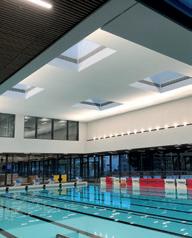
Knauf Insulation has launched Rocksilk RainScreen FFCB (fixed-face cavity barrier), the first cavity barrier that is fixed to the face of the insulation and built in to masonry facades during construction. The patented non-combustible solution was developed in response to customer feedback. It is part of a certified system that provides fire resistance for up to 90 minutes insulation and integrity (EI90) in the residual cavities of buildings with masonry facades. “Unlike other products, our cavity barrier is fixed to the face of the insulation as the brickwork is built, so the insulation doesn’t need to be cut post installation,” explains Luke Davies, Product Manager – Rock Mineral Wool at Knauf Insulation. “This means it’s quicker and easier for brickwork contractors to install, reduces waste on site and gives architects reassurance that performance won’t be compromised by the creation of unintentional air gaps during installation.” Rocksilk RainScreen FFCB is noncombustible with the best possible Euroclass A1 reaction to fire classification.
www.knaufinsulation.co.uk/rainscreen-solutions
01744 766666
sales@knaufinsulation.com
www.smartroof.co.uk
info@smartroof.co.uk
A significant milestone of a university’s estate masterplan has been completed with the use of an acoustic system solution provided by Sto. The company’s StoSilent Distance system and StoDecosit interior plaster now provide a practical and comfortable acoustic environment for the new 25m, eightlane pool at the University of Portsmouth’s £57m Ravelin Sports Centre. The StoSilent Distance system was installed as a suspended ceiling using Sto’s specially-protected sub-construction, which is epoxy powder coated to protect against corrosion.
StoSilent Distance acoustic boards were then fixed to the subconstruction, which can be adjusted to any shape of room to form a homogeneous, seamless surface. “StoSilent Distance is an excellent choice as the insulation boards are manufactured using 96% recycled glass granulate,” comments James Gosling, Sto’s Technical Consultant. “Providing a reliable and effective acoustic treatment in the harsh environment of a swimming pool can be a real challenge, but our StoSilent Distance system has been proven on this type of application many times over.”
www.sto.co.uk
0330
38
ROOFING, CLADDING & INSULATION
024 2666 d.newton@sto.com
CHOSEN TO PERFORM
Pilkington Suncool™ Range Solar Control Glass
Manufactured in the UK, the Pilkington Suncool™ Range offers high performance solar control, low-emissivity glazing for both commercial and residential applications. With varying levels of solar control, thermal insulation, and light transmittance, you can specify the most ideal glass for your projects, while `future-proofing’ for the new Approved Documents L and O.
Specify Pilkington Suncool™ for your project through us at enquiries@pilkington.com, or arrange the supply via one of our trusted partners at www.pilkington.co.uk/suncoolpartners

39
© Lars Ditlev Pedersen
SENIOR OFFERS SPECIFIERS A FENESTRATION HEALTH CHECK
With the deteriorating condition of existing NHS facilities continuing to be a major concern, leading manufacturer Senior Aluminium Systems is launching a new technical advisory service to help specifiers working in the healthcare sector identify the most efficient ways to improve fenestration design.
From upgrading the safety and security of doors, to maximising daylighting with curtain wall systems and reducing heat loss through windows, Senior’s team of architectural advisors is offering freeof-charge consultations and technical support to assist with the ongoing refurbishment and repair of healthcare buildings.
A key part of this service is identifying ways to improve the energy efficiency of the fenestration design to reduce operational costs and carbon emissions, as outlined by the recently-launched NHS Net Zero Building Standard. This new guidance aims to create more sustainable and efficient facilities that are cost effective to build and maintain.
Senior’s expertise in the development of thermallyenhanced and Part L-compliant aluminium windows, doors and curtain wall systems is supported by its in-house technical team that can advise on U-value calculations and other key considerations, such as acoustic performance, solar gain, ventilation and safety guidance to prevent injuries and falls from height. Senior can also demonstrate how maintenance requirements can be reduced by using durable and fully recyclable aluminium fenestration systems, and how working with a UK-based manufacturer can limit levels of embodied carbon.
With a strong supply chain, which includes specialist glazing partners and a national network of experienced fabricators and installers, Senior Architectural Systems has worked on numerous contracts across both the NHS and private healthcare sector.

01709 772600

ALLEGION LAUNCHES NEW SET OF BRITON ‘FIRE DOOR SAFETY’ GUIDES

Allegion UK, a pioneer in fire safety hardware and manufacturer of ‘Briton’ door controls and exit hardware, has launched its new set of best practice guides, designed to provide a broader understanding of fire door safety in commercial, education and healthcare environments. In support of fire safety practice, the three ‘Fire Door Safety in Review’ guides have been compiled using original research from commercial, education and healthcare sectors, drawing upon key insights from building managers and door hardware specialists. Allegion’s research has uncovered several findings and emphasises a fundamental misunderstanding of fire safety responsibility and the importance of fire door hardware across all three fields.
www.briton.co.uk/en/tradeprofessionals/firedoorsafety.html
0300 808 0617
customersupportuk@allegion.com
KEYLITE
www.seniorarchitectural.co.uk
enquiries@sasmail.co.uk
Keylite Roof Windows is offering a new CPD webinar entitled ‘Addressing Thermal Performance’. Primarily aimed at architects, specifiers and housebuilders, Keylite’s webinar tackles the performance gap in roof window specification, providing solutions as to how thermal performance can be assured to achieve Part L and avoid thermal bridging, condensation and heat loss. The webinar is hosted by Keylite Specification team, Executive Cathal McShane and John Logue, Business Manager (Flat Roof Systems), featuring advice and recommendations from the BRE and NHBC. To register your interest in booking a free CPD space or group session, visit the website or use the contact details below.

www.keyliteroofwindows.com/architects
01283 200158 cathal.mcshane@thekeystonegroup.co.uk
STRENGTHENING THE TEAM AT THE WINDOW COMPANY (CONTRACTS)
Specialist commercial installer The Window Company (Contracts) continues to invest in its team with the appointment of Katie Balmford as an Accounts Assistant. Katie has more than 20 years’ experience working in admin and accounts and an NVQ2 in Business Administration, so is a valuable new addition to the team. She is processing invoices, preparing month-end reports and providing support to Rachel Petre, the company’s Director of Finance. The Window Company (Contracts) has grown significantly in recent years, buoyed by ongoing window and door replacement contracts with some of London and the South East’s largest social housing providers and substantial new contract wins in the new-build housing sector.
www.thewinco.co.uk
01245 268120
40
DOORS & WINDOWS
ANNOUNCES NEW CPD WEBINAR
Liquid Roofing & Waterproofing


Long term protection for flat roofs, buildings and critical structures



The first choice for liquid membranes
Warm roofs, inverted roofs, green roofs, podium Whatever your requirements, we have a certified and proven solution to meet your needs.
With over 60 years’ experience, there’s not many challenges we haven’t faced, confronted and overcome.
Contact us to discuss
Whether it’s a school, hospital, hotel, car park, balcony, the list is endless, KEMPEROL® has a range of cold applied products to suit every application.
visit www.kemperol.co.uk
To find out more about the KEMPEROL® range of products
Tel: 01925 445532
Email: enquiries@kempersystem.co.uk

41 KEMPEROL®
Kemperol Liquid Waterproofing KEMPEROL®
95/3139
06/4388
WELLINGTON’S PRIDE IN THE COMMUNITY WITH HELP FROM BRETT LANDSCAPING
In-depth technical advice and bespoke design solutions from independent paving manufacturer Brett Landscaping helped a local council with part of a £35m programme of works to keep neighbourhoods safe, clean and well connected.

As part of the wider four-year scheme, Telford and Wrekin Council had made a £450,000 commitment to residents in Wellington to make their town centre more attractive, more accessible and safer for pedestrians.
Major redevelopment of Market Street, Wellington, started in October
2022 with the first phase completed before Christmas. The work included pavement resurfacing, widening the footpath, replacing all kerbs and installing new drainage, which improved the aesthetics and accessibility while still maintaining a one-way street with parking/loading provision.
Brett Landscaping’s specialist team offered extensive advice on the technical elements of the project in the planning stage and Telford Council specified Brett’s Invicta block paving for the project.
Invicta’s unique Aggtech surface layer provides a hardwearing surface for the high volume of pedestrians that travel through the town centre while retaining its vivid colours. Invicta Pearl (60mm) block paving was used in conjunction with Onyx 80mm pavers – all of the Invicta colour schemes complement each other but can also provide demarcation.
Brett Landscaping’s design teams then produced bespoke cross sections for the installation of the drainage channel block and its integration with the road kerbs. The channels run from the shopfronts to the conservation kerb; at the downpipe positions from the rooftops and acted as a demarcation and rigid lateral restraint across the footpaths. This required bedding in mortar to take up the differences in the depth of the blocks.
All Brett’s concrete block paving is manufactured to comply with British Standards for all physical performance ratings, BREEAM ratings, sustainability credentials and responsible sourcing certifications.
www.brettlandscaping.co.uk
0345 608 0577
landscapinginfo@brett.co.uk
ENVIROVENT EXPANDS ITS VENTILATION RANGE WITH WHOLE-HOUSE HEAT RECOVERY SYSTEM
BURG-WÄCHTER’S SECURE COMMUNITIES SCHEME DOES ITS BIT FOR FOODBANK

At a time of cost-of-living rises and fuel poverty, Burg-Wächter UK’s ‘Secure Communities Scheme’ is providing a much-needed boost for a foodbank and coastal discounted food shop. The security specialist received a moving plea for help from Wells Foodbank and Coastal Community Supermarket for the free-of-charge security support that the Secure Communities Scheme affords. As a result, Burg-Wächter donated a cash deposit safe featuring electronic locks plus three combination locking bolts. Burg-Wächter launched the scheme in recognition of the fact that people around the country who are doing their bit for their community should not have to worry about the security of their premises, equipment or storage areas.
www.burg.biz/uk 01274 395333
EnviroVent, one of the UK’s leading ventilation manufacturers, has launched a new MVHR (mechanical ventilation heat recovery) range, which is Passivhaus certified. The Sabik 350 and 500 series have been designed to provide balanced and sustainable ventilation for new and refurbished homes, incorporating modular features, with user-friendly controllability. The Sabik 350 and 500 systems have significant airflow capacity of up to 414m3hr and 601m3hr respectively, and are suitable for handing airflow directions and drain on site to offer flexibility when it comes to ducting configurations. These modular units incorporate a range of features as standard, including integrated relative humidity sensor, touchscreen controller and frost protection.
www.envirovent.com
NEW DORCHESTER DR-SG WATER HEATER PROVIDES A DURABLE AND LONG-LASTING SOLUTION


0845 272 7810
Hamworthy Heating, a trusted British manufacturer and supplier of commercial heating and hot water products, is pleased to announce the introduction of its new Dorchester DR-SG range of stainless-steel condensing water heaters with enhanced durability and large continuous outputs. The Dorchester DR-SG is available in 10 power outputs over three storage capacities and features a durable stainless-steel tank, heat exchanger and coil for enhanced performance, efficiency and increased service life. Incorporating a user-friendly design, Dorchester DR-SG water heaters are operated via the popular Siemens LMS mini controls platform. The Dorchester DR-SG is supplied with a five-year warranty on the tank and a two-year warranty on the components.
01202 662552
www.hamworthy-heating.com
sales@hamworthy-heating.com
42
FOCUS & INNOVATION



































 Beth Elkins Gretton School Cambridge, UK
Beth Elkins Gretton School Cambridge, UK







































































